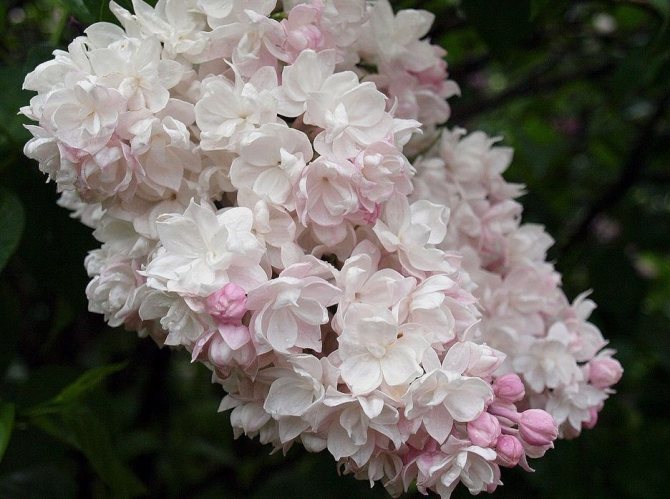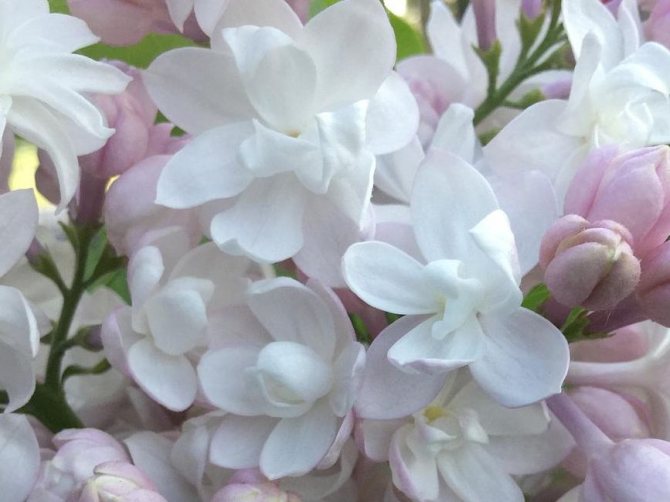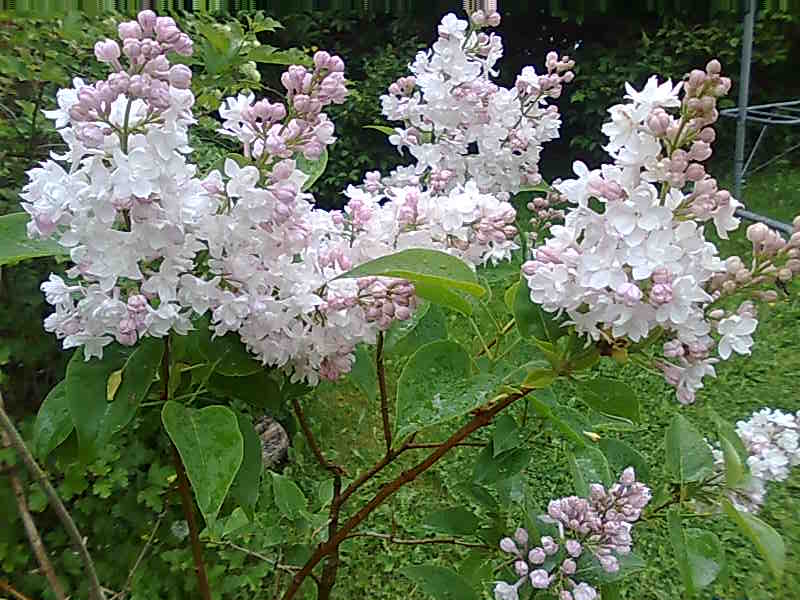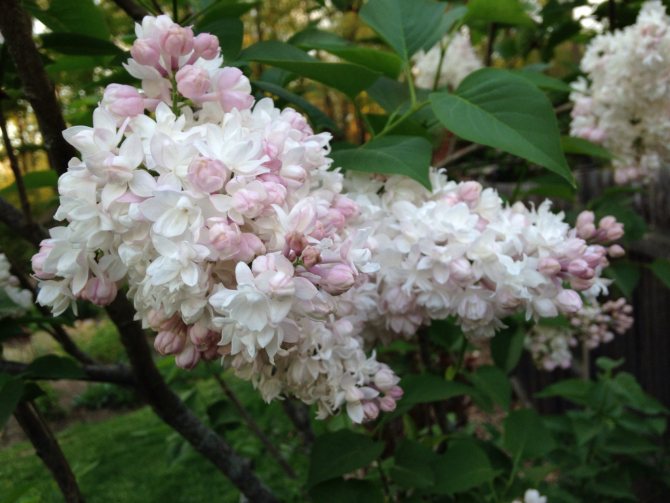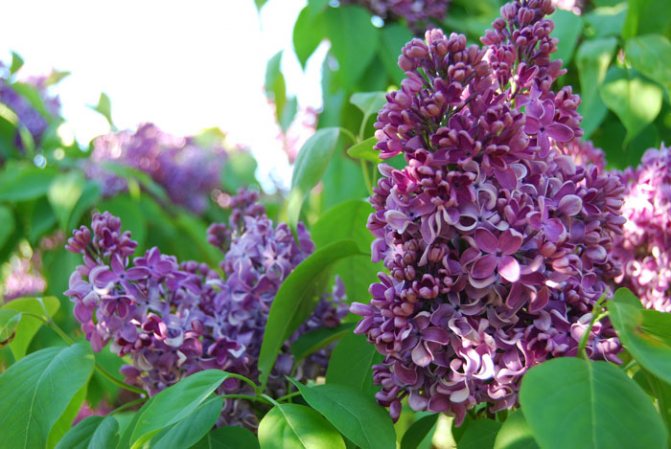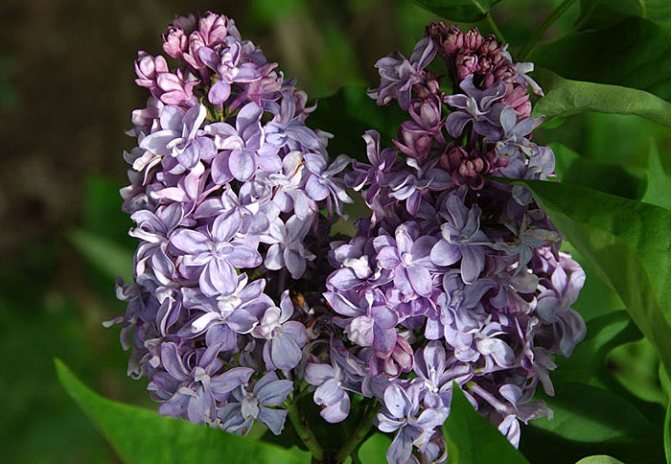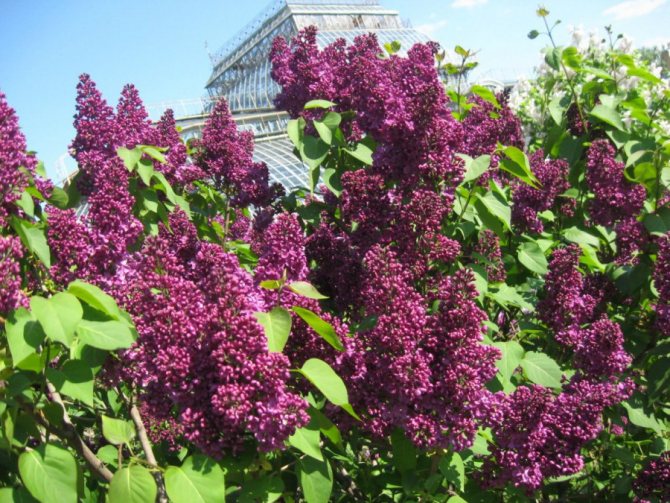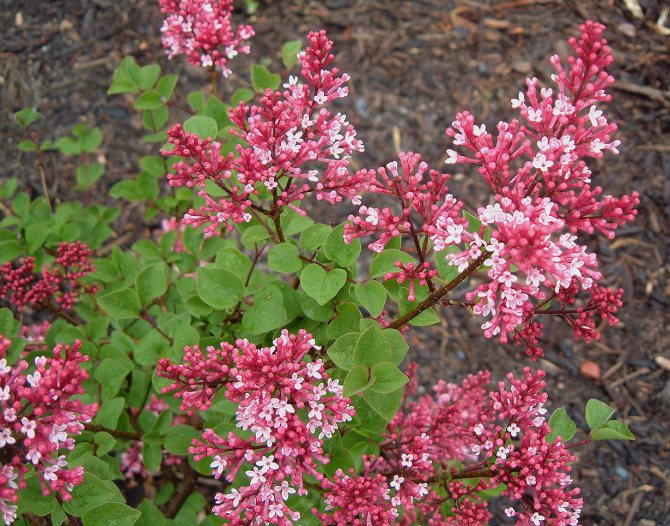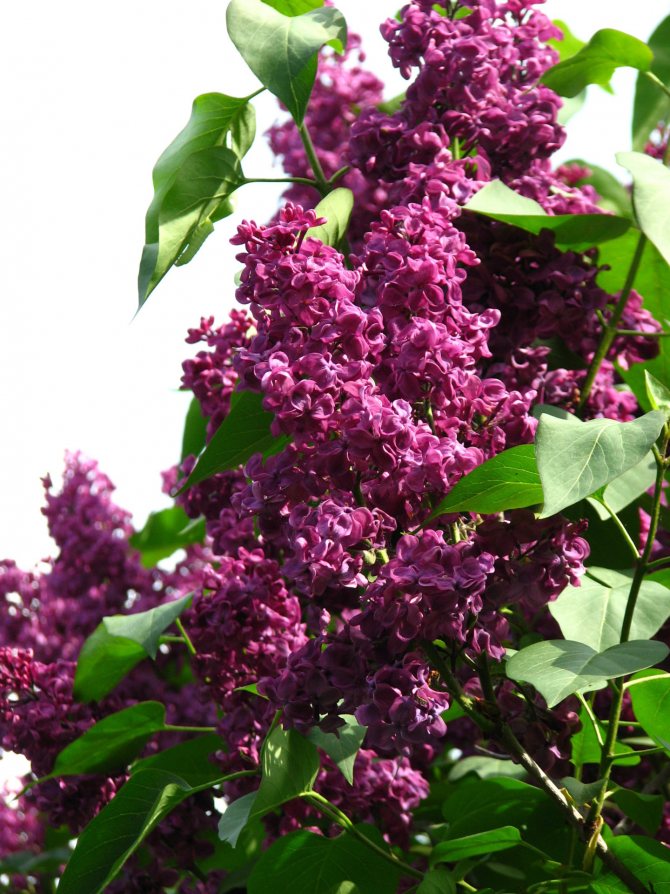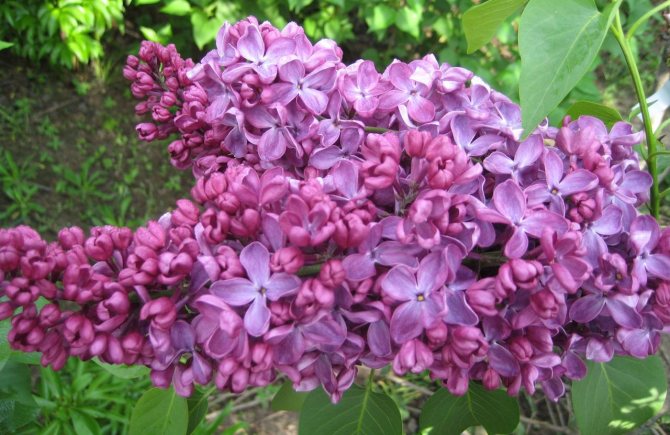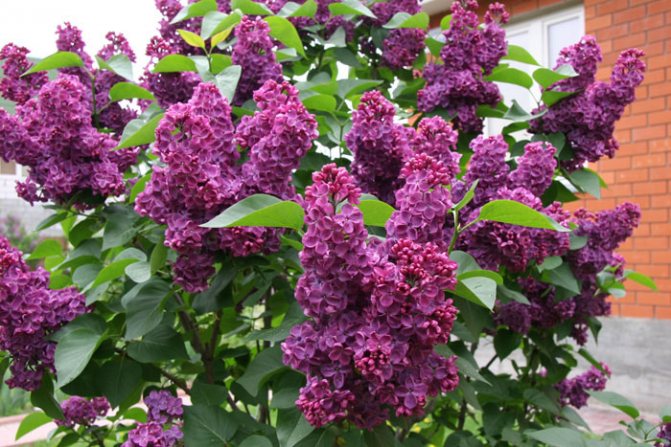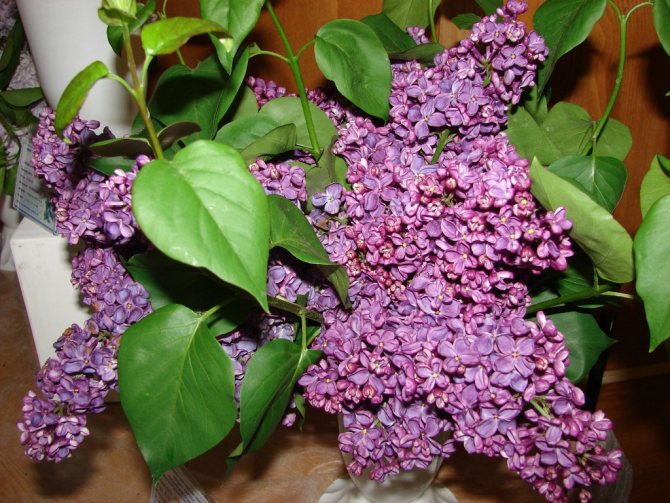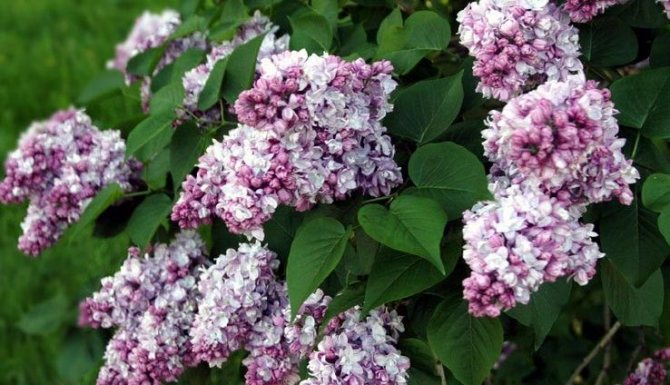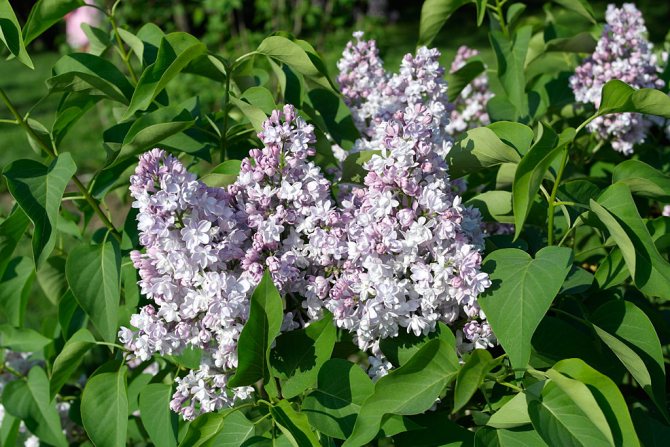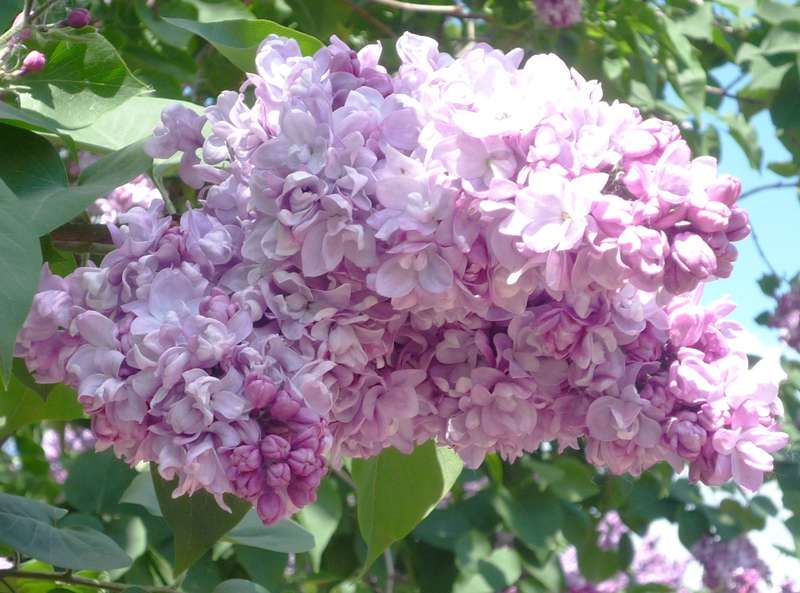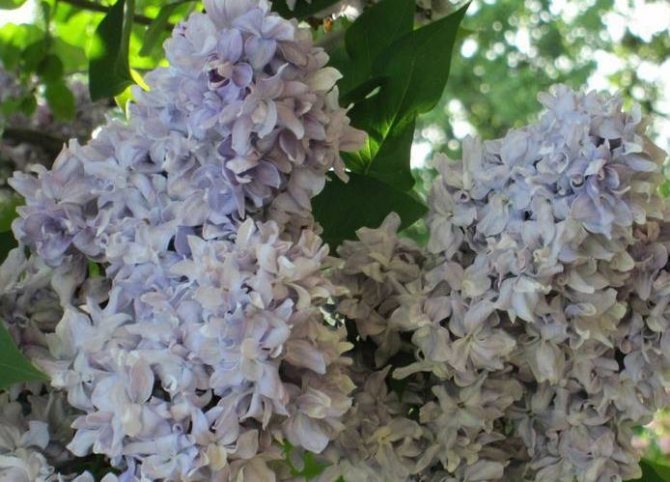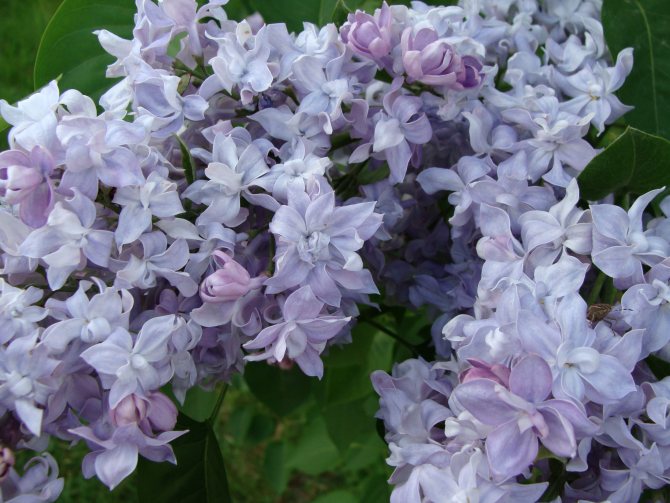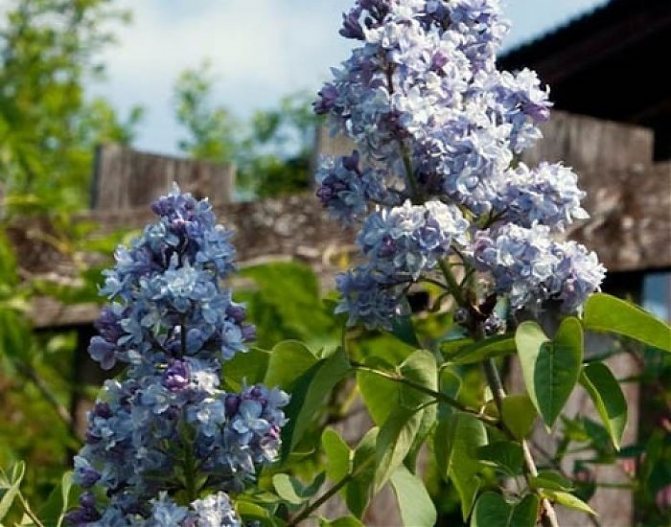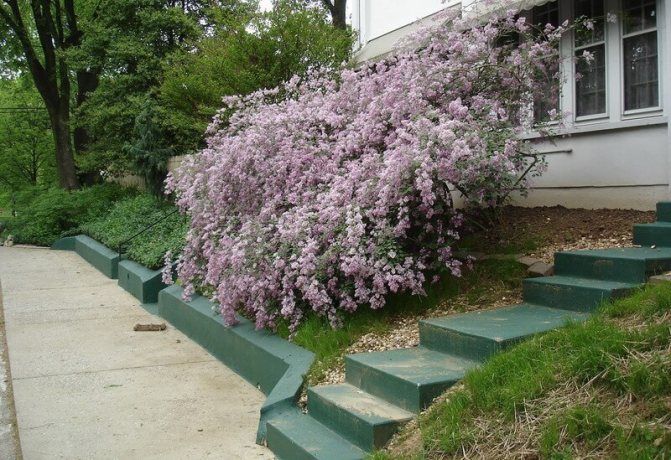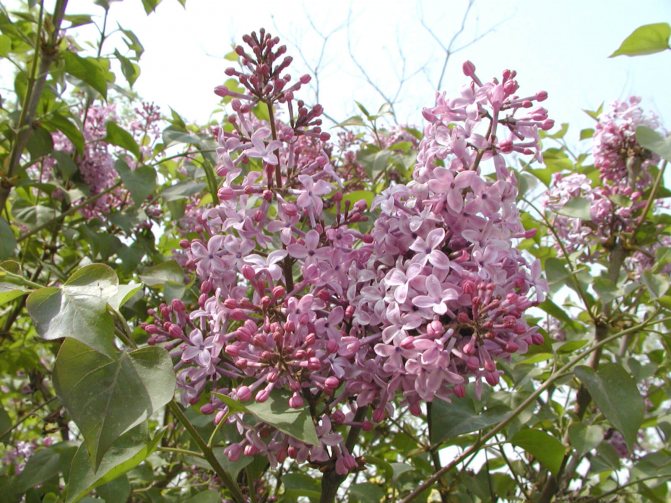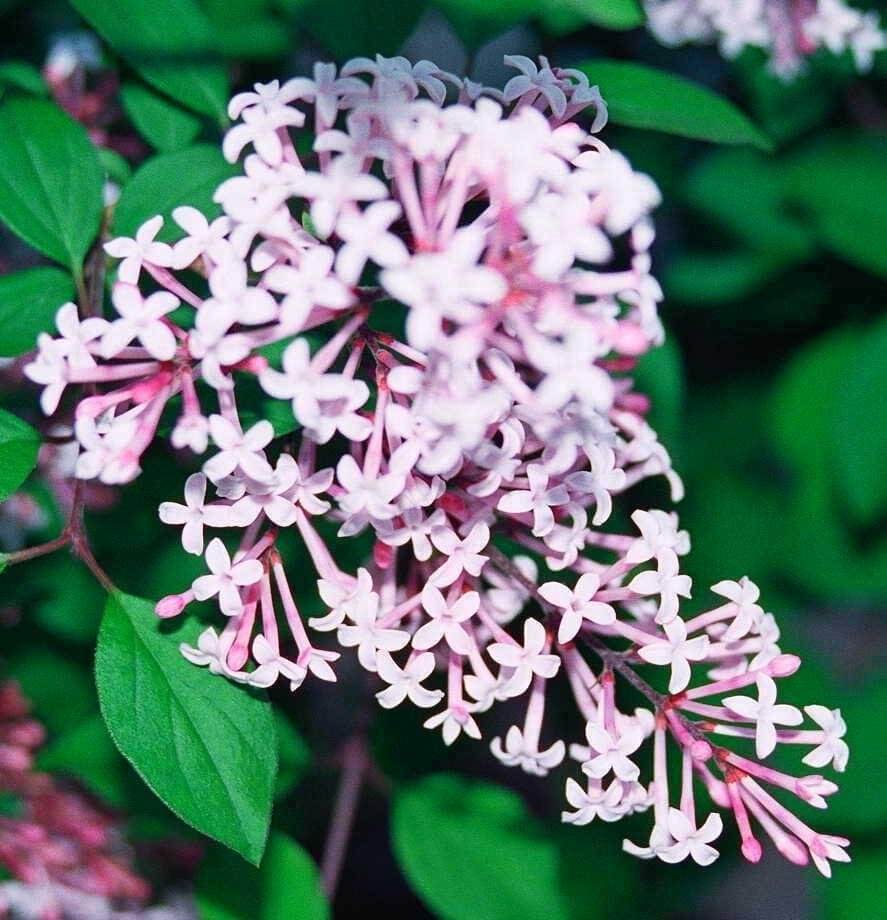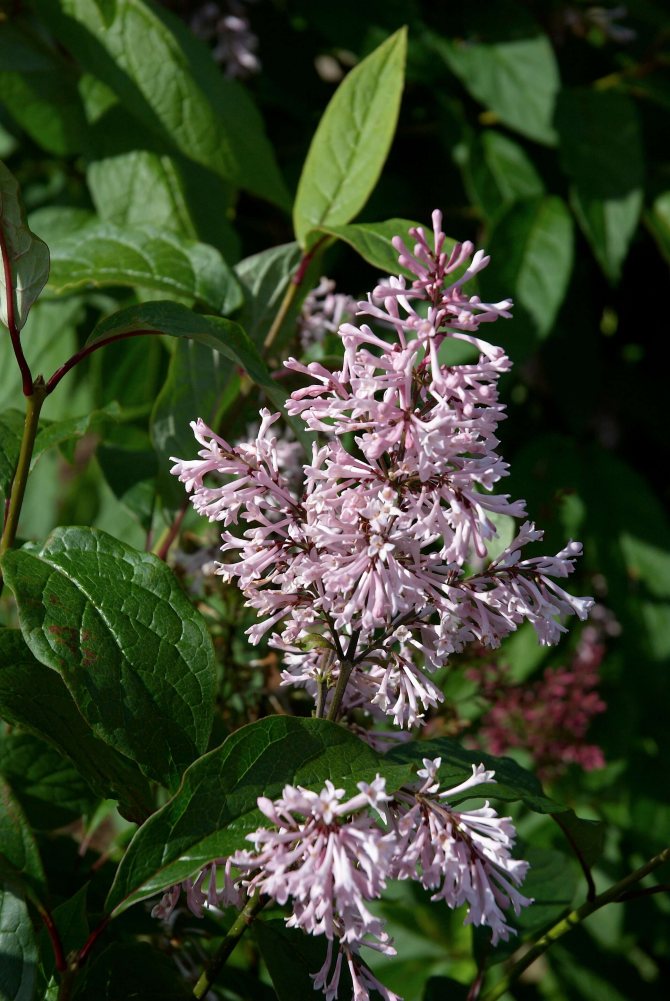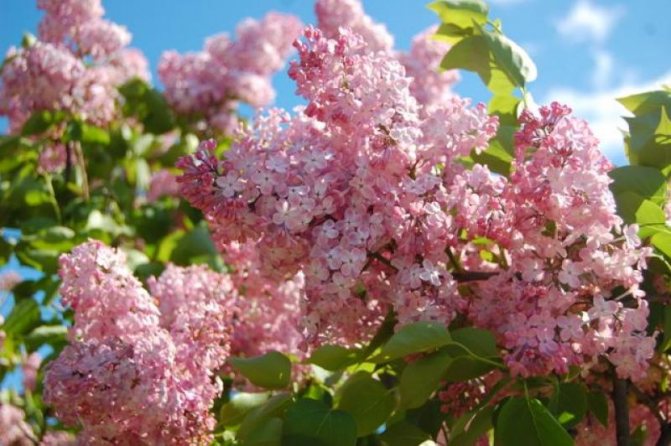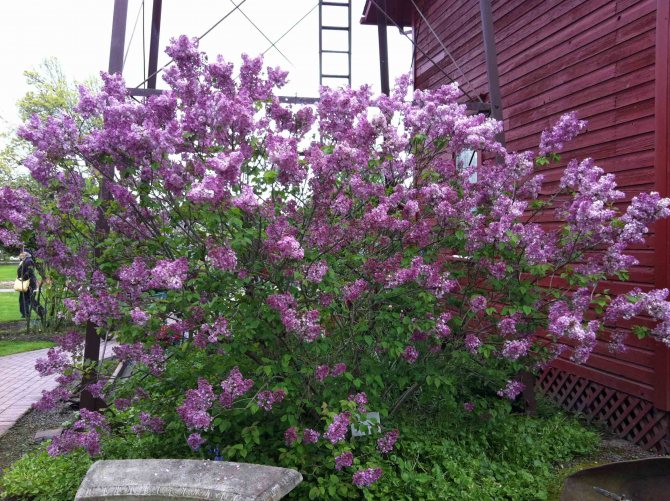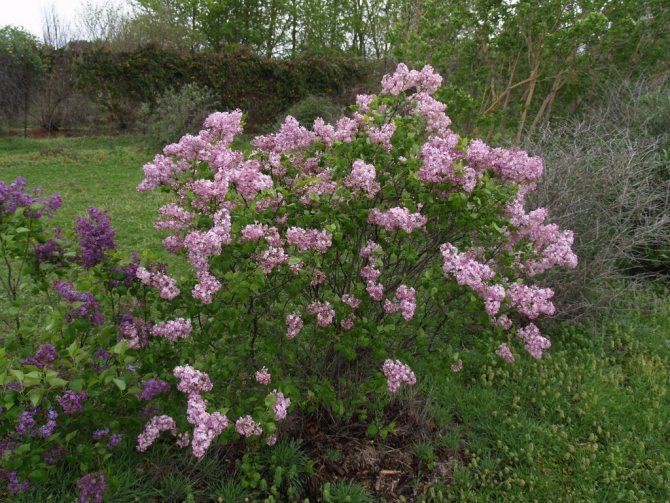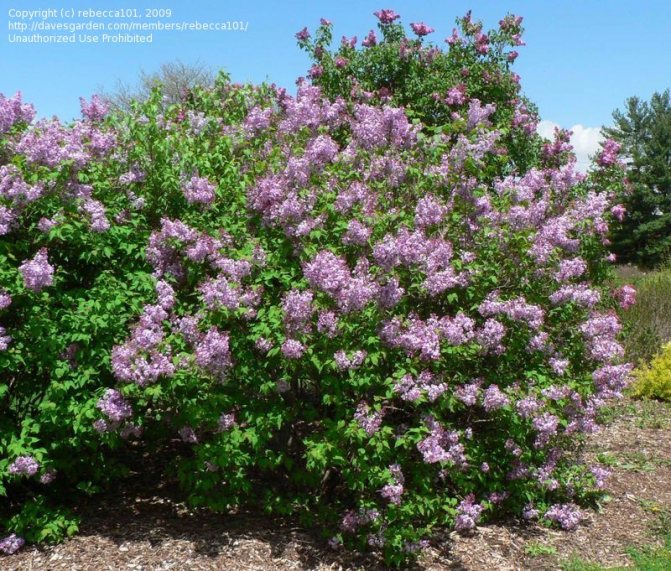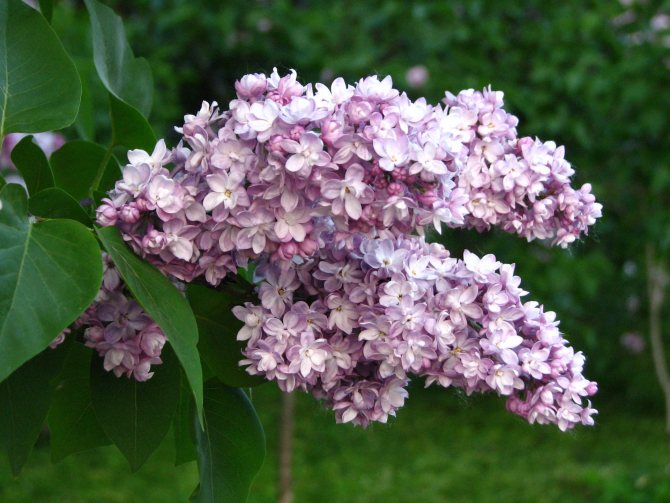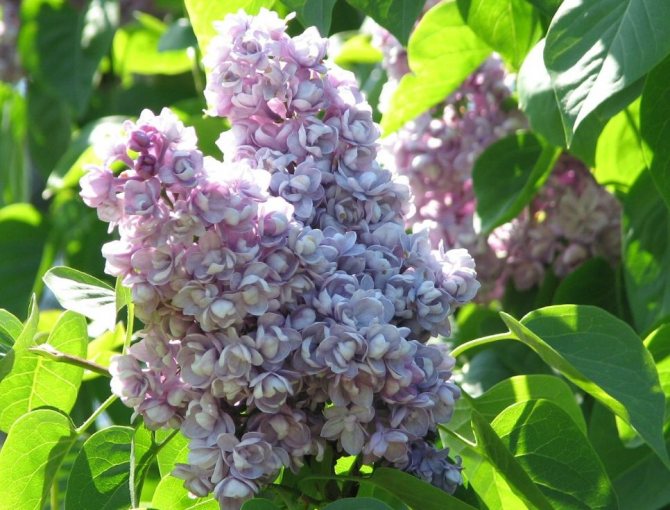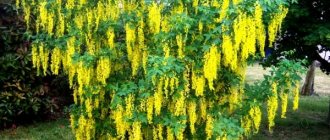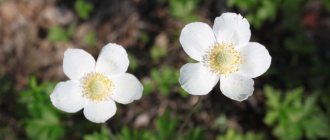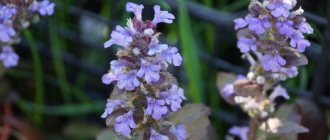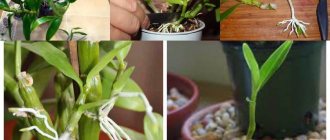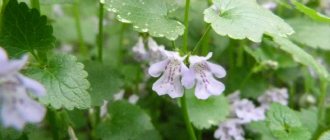Such a shrub as lilac is a representative of the olive family. According to information taken from various sources, this genus unites from 22 to 36 species. In nature, such species can be found in the mountainous regions of Eurasia. The genus lilac has a typical species - common lilac (Syringa vulgaris). Under natural conditions, such a shrub can be found along the lower course of the Danube, on the Balkan Peninsula and in the South Carpathians. Lilac is cultivated as an ornamental plant, and it also strengthens and protects slopes that are exposed to erosion. In the second half of the 16th century, the Roman ambassador brought lilacs to European countries from Constantinople, since that time this plant has appeared in the gardens of Europe. The Turks called this shrub "lilak", and the inhabitants of Germany, Flanders and Austria gave it the name "lilac" or "Turkish viburnum".
At first, lilacs were not in great demand among European gardeners, because it did not bloom for long, and loose inflorescences with small flowers did not have a high decorative effect. But everything changed after the Frenchman V. Lemoine received several dozen varieties of this plant, which were distinguished by lush and long flowering, as well as beautiful dense inflorescences with the correct shape. He also managed to breed several varieties with double flowers of various colors. Emile Lemoine continued his father's activities, as did his son Henri. Thanks to the Lemoans, 214 varieties of lilacs were born. Of the French breeders of lilacs, they paid attention to: Auguste Gouchaux, Charles Balte and François Marel. At the same time, in Germany, Wilhelm Pfitzer and Ludwig Shpet worked on the development of new varieties of lilacs. In Holland, at the beginning of the 20th century, new varieties of this shrub were born, and Klaas Kessen, Dirk Evelens Maarse, Jan van Tol and Hugo Koster worked on this, and the Polish breeder Karpov-Lipski also worked in this direction.
At the beginning of the 20th century, lilac became quite popular in North America, while its new varieties were born thanks to such breeders as John Dunbar, Gulda Klager, Theodore Havemeyer and other rather famous specialists from Canada and the United States. Also, new varieties of lilacs were bred on the territory of Belarus, Russia, Ukraine and Kazakhstan. Today, there are more than 2300 varieties of this plant, which differ in color, size and shape of flowers, flowering time, habit and size of bushes. 2/3 of all varieties were bred using common lilac.
Shrub description
Hungarian lilac (Latin: syringa josikaea)
- a shrub with a dense deciduous crown, which has an ovoid shape. Its height can reach up to 3-4 meters. The crown diameter can be up to 4 meters. The shrub leaves are elliptical. The length of the leaf reaches from 6 to 12 cm. In spring and summer, they are dark green, yellow in autumn.
The shrub reaches its special beauty during the flowering period. Description of lilac color: tubular flowers are collected in pyramidal inflorescences. Their color is bright purple. The size of the flower does not exceed 1 cm. The photo shows the flowering of the Veneger lilac.
Hungarian lilac picks up color 7-10 days later than common lilac. The flowering period lasts up to 20-25 days.
Types and varieties of lilacs with photos and names
There are about 30 types of lilacs, most of which can be found in gardens and parks. Below will be a description of the most popular species and varieties of such a shrub.
Amur lilac (Syringa amurensis)
This shade-loving hygrophyte is found in the deciduous forests of the Far East and northeastern China. This species needs a well-moistened soil. It is represented by a multi-stemmed tree, which has a lush spreading crown. Plant height is about 20 meters. This species is cultivated as a shrub, the height of which does not exceed 10 meters. The shape of the foliage of this plant is similar to the leaf plates of common lilac. When the leaves are just opening, they are purple-green in color, in the summer their front surface is dark green, and the back is paler. In autumn, the color of the foliage changes to yellow-orange or purple. The length of the strong panicle inflorescences is about 25 centimeters, they consist of small white or cream flowers with a honey smell. Such a plant is frost-resistant and does not need shelter for the winter. It is grown both solo and in group plantings, and this shrub is also suitable for creating a hedge. Cultivated since 1855
Hungarian lilac (Syringa josikaea)
The homeland of this species is Hungary, the Carpathians and the countries of the former Yugoslavia. The height of the shrub is about 7 meters. Branched dense stems directed upwards. Glossy dark green leaf plates of broadly elliptical shape reach a length of 12 centimeters and have a ciliated edge. The lower surface of the leaf plates is greenish-gray, sometimes there is pubescence on the central vein. Rare narrow panicle inflorescences are divided into tiers. They consist of small flowers of lilac color with a mild odor. Such a plant is unpretentious, resistant to urban conditions, it is widely used to create group and single plantings. Cultivated since 1830. Popular garden forms:
- Pale... The color of the flowers is light purple.
- Red... The inflorescences are purple-red.
Meyer's lilac (Syringa meyeri)
The compact plant reaches a height of only 150 cm. The length of small leaf plates is from 20 to 40 mm, their shape is elliptical, tapering towards the top, and have a ciliated edge. The front surface of the foliage is naked, dark green, and the back is paler and has pubescence along the veins. The length of erect inflorescences is 3-10 centimeters, they consist of fragrant pale flowers of pink-lilac color. The species is frost-resistant.
Persian lilac (Syringa x persica)
This hybrid was obtained by crossing finely cut lilacs and Afghan lilacs. The height of the shrub is about 3 meters. The length of dense thin leaves is about 7.5 centimeters, they are pointed, lanceolate. Wide, loose panicle-shaped inflorescences consist of fragrant lavender flowers, the diameter of which is 20 mm. Cultivated since 1640. Popular forms:
- White lilac. The color of the flowers is white.
- Red lilac with red flowers.
- Dissected. This dwarf Persian lilac has spreading branches and small pinnately-lobed openwork leaf plates.
Chinese lilac (Syringa x chinensis)
This hybrid was obtained by crossing Persian lilac and common lilac. This species was obtained in France in 1777. The height of the bush is about 5 meters. The length of the ovate-lanceolate pointed leaf plates is about 10 centimeters. The length of the broad-pyramidal drooping panicle inflorescences is about 10 centimeters, they consist of very fragrant flowers, the diameter of which is 1.8 cm.The flowers in the buds are painted in a deep purple color, and when blooming they are purple-red. Popular forms:
- Double. The color of the double flowers is purple.
- Pale purple.
- Dark purple. This form is the most effective of all those related to Chinese lilac.
Lilac hyacinth (Syringa x hyacinthiflora)
This hybrid is the result of the work of V. Lemoine. It is created using common lilac and broadleaf lilac. The leaf plates have a sharp apex and are broadly ovate or heart-shaped. In autumn, their dark green color changes to purple-brown. The flowers are similar to those of common lilac, but the inflorescences are less dense and smaller. It has been cultivated since 1899. The terry form has the greatest effect, there are several more popular forms:
- Esther Staley... The color of the buds is red-purple, and the fragrant flowers are rich red-purple. The diameter of the flowers is about 20 mm, their petals are bent back. The length of the inflorescences is about 16 centimeters.
- Churchill... The color of the buds is violet-red, and the blossoming fragrant flowers are lilac-silver with a pinkish tint.
- Puple Glory... Dense inflorescences consist of large (diameter 35 mm) simple purple flowers.
Common lilac has been cultivated since 1583, it has a large number of varieties created by both domestic and foreign breeders. For example:
- Red Moscow... The color of the buds is purple-violet, and the fragrant flowers are dark purple. They reach 20 mm in diameter and have yellow stamens.
- Violet... It has been cultivated since 1916. The buds are dark purple, and the double and semi-double large (diameter about 30 mm) flowers are pale purple. They have a low odor.
- Primrose... The buds are yellow-green and the flowers are pale yellow.
- Belicent... The shrub is straight and tall. The length of fragrant openwork pink-coral inflorescences is about 0.3 m. The shape of large slightly corrugated leaf plates is oval.
In addition to these varieties, garden lilacs are popular with such as: Belle de Nancy, Monique Lemoine, Amethyst, Amy Schott, Vesuvius, Vestalka, Galina Ulanova, Jeanne d'Arc, Cavour, Soviet Arctic, Defenders of Brest, Captain Balte, Katerina Havemeyer, Congo, Leonid Leonov, Madame Charles Suchet, Madame Casimir Perrier, Dream, Miss Ellen Wilmott, Montaigne, Hope, Donbass Lights, Memory of Kolesnikov, Sensation, Charles Joly, Celia, etc.
Gardeners also grow the following species: Peking lilac, drooping, Japanese, Preston, Juliana, Komarova, Yunnan, fine-haired, shaggy, Zvegintsev, Nansen, Henry, Wolf and velvety.
Varieties and forms of Hungarian lilac
Most modern varieties are based on common lilac. Russian nurseries do not offer their varietal variety among the Hungarian. In horticultural culture, there is only a standard shrub and several of its forms.
Hungarian forms:
- pale (in Latin: Syringajosikaea f. pallida) has a pale lilac color with a shade of fading;
- red-flowered form (Syringajosikaea f. rubra) - purple, with a reddish tint;
- white-flowered form (Syringajosikaea f. monstrosa) - white flowers;
- pink (Syringajosikaea f. rosea) - pink color of flowers, pastel, with a lilac tint.
Features of the Hungarian species
If the differences between Hungarian and common lilacs are obvious, then it is quite easy to confuse a plant with a Persian species. The shoots of the Persian plant are very thin. The Hungarian version has thick and strong shoots. Lilacs from Hungary are endowed with great winter hardiness, which cannot be said about the Persian counterpart, which freezes even with slight frosts.
The common Hungarian friend is related to the common lilac by the fact that both species do not shed their leaves until the first frost. The real homeland of the Hungarian lilac is the Carpathians. Shrub grows from Hungary to the Arctic.
Favorable conditions for planting Hungarian
For good growth of Hungarian lilacs, it is necessary to take into account all favorable conditions for planting: light, soil, moisture-loving, weather conditions.
Conditions for growing Hungarian:
- photophilous;
- undemanding to the composition of the soil;
- resistant to frost;
- drought-resistant.
The main criterion for choosing a landing site is a well-lit area, sheltered from the wind. Hungarian lilac is a photophilous plant.
Attention! The longevity of the plant should be noted.Hungarian lilac - subject to all favorable conditions, it can live for more than 100 years. Over the entire duration of its life, such a plant becomes fruitful up to 90 times.
The shrub is not picky about the soil. But you should not plant it in a wetland flooded in the autumn-spring periods. Lilac roots are sensitive to dampness, even a short stay in water leads to rotting and death of the root system. The ideal soil for her is fertile, with a good drainage layer, moderately moist soil. A slightly acidic or neutral soil composition is best suited.
Features of lilac

Lilac is a deciduous, multi-stemmed shrub that varies in height from 2 to 8 meters. The trunk diameter is about 0.2 meters. The color of the bark is brown-gray or gray. Young trunks are covered with smooth bark, while old ones are fissured.
The foliage bloom relatively early, while it stays on the branches until the onset of frost. The length of opposite leaf plates is about 12 centimeters, as a rule, they are solid, but there are also pinnately-separated. In different species, the shape of the leaf can differ, for example, it can be heart-shaped, oval, ovoid or elongated, sharpening in the upper part. The color of the foliage is dark or pale green. The length of the terminal drooping panicle inflorescences is about 0.2 m, they include flowers that can be colored lilac, blue, pink, white, purple or violet. The flowers have a short, bell-shaped, four-toothed calyx, 2 stamens and a corolla with a four-part flat limb and a long cylindrical tube. Many are interested in exactly when the lilac flowers bloom. It depends on several factors, namely: the species, weather and climatic conditions. Such a shrub can bloom from the last days of April to the first - June. During the flowering of lilacs, the garden is filled with a unique, delicate and very pleasant aroma. The fruit is a bivalve capsule with several winged seeds inside.
If you provide the plant with the most favorable conditions, then its life expectancy can be about 100 years. Lilac is very easy to care for, it is frost-hardy and is one of the most popular ornamental shrubs, along with hydrangea and chubushnik (garden jasmine).
Landing
Hungarian lilac takes root well and gives an increase in the first season, if it is planted in mid-July to early autumn. The shrub is planted in cloudy weather. As a rule, the soil in late autumn and spring has a high degree of moisture. This negatively affects young roots. Saplings during this period take root poorly and do not immediately give an increase. Lilac bushes are planted at a distance of 2-3 meters from each other.
Preparation for planting begins with the arrangement of planting holes. The size of the pits depends on the composition of the soil: fertile soil - 50 cm by 50 cm, sandy soil - 1 m by 1 m. They are dug with sheer walls.
The planting pits are filled with a special substrate consisting of compost, wood ash, superphosphate.
Substrate composition:
- humus or compost - 15-20 kg;
- ash - 200-300 g;
- superphosphate - 20-30 g.
Superphosphate is an oxidizing agent. The proportion of ash must be correctly calculated based on the acidity of the soil. To neutralize superphosphate in conditions of high acidity, it is recommended to increase the proportion of wood ash.
Planting lilacs in the garden


What time to plant
The best time to plant lilacs in open soil is from mid-July to early September. It is not recommended to plant such a shrub in spring or autumn, as it does not take root well and almost does not grow for 1 year.For planting, choose a sunny place with moderately moist soil saturated with humus, and its acidity should be 5.0-7.0.
When buying seedlings, be sure to carefully examine their root system. You should stop your choice on a plant with a well-developed and branched root system. Before planting a seedling, all injured roots that have begun to dry out and damaged by the disease should be cut out from it, the remaining ones should be shortened to 0.3 m. Injured stems should be removed, and excessively long ones should be shortened.
Landing features
When planting several seedlings, do not forget to leave an empty space between them from 2 to 3 meters (depending on the type and variety). When preparing a pit for planting, it should be borne in mind that it must have sheer walls. If the soil fertility is high or medium, then the size of the pit will be 0.5x0.5x0.5 meters. If the soil is poor or sandy, then the hole needs to be made 2 times larger, because during planting the seedling it will be necessary to fill it with a nutritious soil mixture, which includes: humus or compost (from 15 to 20 kilograms), wood ash (from 200 up to 300 grams) and superphosphate (20 to 30 grams). Wood ash should be taken 2 times more if the soil on the site is acidic.
At the bottom of the pit, you need to make a good drainage layer, for this you can use crushed stone, expanded clay or broken brick. Then a nutrient mixture is poured into the pit in such a way that a mound is obtained. Further, the plant is installed in the center of the pit directly on the mound. After its root system is straightened, the pit must be completely filled with soil mixture. In planted lilacs, the root collar should rise by 30–40 mm above the surface of the site. The planted shrub must be well watered. When the liquid is completely absorbed into the soil, its surface will need to be covered with a layer of mulch (peat or humus), the thickness of which should be within 5-7 centimeters.
How to choose the right seedlings for planting?
In order for the Hungarian lilac to take root well, special attention should be paid to the choice of a seedling. It should not be tall, its crown is trimmed into three buds. Examine the roots carefully before purchasing a seedling. The stalk for planting must have a healthy, well-branched root system. The preferred length is at least 25 cm. Before planting, it is recommended to carefully examine the roots. Damaged processes are removed completely, and too long are neatly trimmed.
When planting, the seedling is placed in the middle of the hole, the root system is gently straightened out. All spines should be pointing down. Lilacs are covered with a pre-prepared substrate and crushed at the base. This will allow the soil to adhere tightly to the roots and provide nutrition to the bush.
What to remember
- Plant in sunny places. Lilac takes root well in sunny places and is distinguished by abundant flowering.
- Protect from the wind. Erect branches are not able to resist gusts of wind and need protection. You can plant lilacs along the fence or wall of the house.
- Propagate by layering or cuttings. The fastest and most reliable propagation of lilacs is considered to be the planting of cuttings. With proper care, young cuttings can bloom the next year under favorable conditions.
Proper care of Hungarian lilacs
After planting, lilacs are watered abundantly with water. 1 bush requires 20-25 liters of water. Then the base is covered with peat composition or humus. In the warm season, it is recommended to loosen the soil (up to 4 times per season).
Within two years after planting, the bush must be fertilized only with nitrogen. It is found in urea and ammonium nitrate. After the lilac gets stronger and takes root, it is fed with a special solution of manure and water (1: 5). Fertilizer should not be poured directly under the trunk, otherwise the lilac will start to rot. The solution is carefully distributed from it at a distance of about 50 cm.
In the fall, fertilizing with potash and phosphorus fertilizers is carried out. It can be superphosphate in a dosage of 40 g per adult bush, potassium nitrate - 35 g, wood ash - 200 g per 8 liters of water.
Watering lilac bushes is carried out only during the period of shoot growth and flowering. Also, in the heat, you need to take care of soil moisture.
The first few years after planting, the trunk circle of young lilacs need shelter for the winter season. For this, peat or dry leaves are suitable. The cover layer must be at least 10 cm.
Pruning
The obvious advantage of the Hungarian lilac is that it does not need frequent pruning and crown formation, since it initially has the correct beautiful shape. Lilacs are cut off only if the crown has become too thick and light does not penetrate inside, and the procedure is carried out only for adult bushes (Figure 4).
Figure 4. Only mature shrubs need pruning
Young plants in the first few years after planting do not need this procedure. Sanitary cleaning and giving the branches a certain shape begin only after 3-4 years of the life of the bush. The procedure is best done in the spring, before the buds are swollen. In this case, it is important to remove only old branches, since flower buds are formed precisely on the young growth of the current year.
Pruning and shaping Hungarian lilacs
Hungarian lilac has its natural beauty of the crown, it is compact and holds its shape without much effort, this is clearly seen in the photo below, which illustrates a variety from one of the Eastern European nurseries.
Syringa josikaea 'Villa Nova'
But for a more austere silhouette, you can do some formative trims. This is not difficult. It is usually sufficient to give the direction of growth. Hungarian perfectly keeps the given shape. The shrub does not require constant cutting. Pruning is done according to a general standard. The crowns of mature bushes are thinned out in early spring before they are actively planted with greenery. Branches are thinned out from the inside. This allows for a beautiful appearance. After flowering, lilac panicles are carefully trimmed.
Popular varieties
The vast majority of subspecies
cultivated from common lilacs and even nurseries cannot boast of a wide variety of varieties. Only a few varieties are widespread in culture.
- Pale
... Differs in a light lilac color close to the natural shade when lilac fading. - Red-flowered
... The species is notable for its purple or reddish hue. - White-flowered
... A common variety, owes its name to its snow-white flowers. - Rosaceous
... It has flowers of a pale pink color with a slight lilac tint.
Hungarian lilac hedge
Hungarian lilac can be an excellent choice for creating a hedge for fencing a site. In order to carry out the correct formation of the hedge, it is necessary to take into account the volume of shrub growth. A large area is allocated for lilacs. Plants are planted in a line at a distance of 1.5 meters.
For the first 3 years, the lilacs in the hedge are not pruned or fertilized. At 4 years old, feeding begins. Regular watering of the fence is not required. Pruning is carried out in order to thicken the bushes. Up to 10 powerful shoots are left on young shrubs. After the lilac gains its strength, pruning is carried out only to shape or to rejuvenate the bare bushes.
Origin story
Of course, as a species, Hungarian lilac has existed for a very long time. People learned about her thanks to one baroness from Hungary, who was fond of gardening.
A noble lady named Yosekia once went for a walk and discovered a strange lilac outside her garden. The tree was slightly different from the generally known species.
Soon, the baroness from Hungary, intrigued by the find, found out that this plant had not yet been described. Therefore, she carefully studied the lilac and described it for the first time.
Seringa Josikaea Jacg - this is how the name of lilac is written in Latin. This already includes the name of the discoverer.
In 1830, the cultivation of lilacs from Hungary began. Since the surname of the baroness turned out to be very complicated, the world knows this species as "Hungarian lilac".
Forming in a standard form
It is noteworthy that the Hungarian lilac looks spectacular in the standard form. The standard form is a lush tree grown on an even trunk with falling branches or a rounded silhouette. To create a decorative trunk, you must select an unvaccinated lilac. In early spring, one is selected from the shoots, which has grown at least 1 meter in height. The roots are cut in a square shape - 20 by 20 cm. A varietal lilac is grafted onto the stalk. In the fall, lilacs are carefully dug up and planted on well-prepared land. Root growth is removed.
The photo shows an example of a lilac formed by a trunk.
Combination with other plants
In the open field, lilacs are everywhere in the yard:
- in hedges;
- in mixborders;
- in combination with other shrubs and low-growing trees (including with other species of lilacs, which differ in terms of flowering);
- in shrub beds;
- in flower beds.
From the Hungarian variety of lilacs, you can form a small standard tree with a spherical crown on a smooth and even trunk. This form looks spectacular during flowering. In March, pick up a strong shoot of an ungrafted bush, from 1 m in height.Cut its roots in the form of a square 20x20 cm, and plant a varietal lilac on the cutting itself. In the fall, plant the hardened specimen in a permanent place, removing the root growth.
The advantageous difference between the Hungarian lilac is the lack of a tendency to overgrow and suppress neighboring plants. The shrub looks very neat, which easily allows it to become the center of almost any landscape composition.
Reproduction
How to propagate an already growing shrub? Hungarian does not give offspring, which determines some difficulty in its reproduction. The main way is grafting. Both green and lignified branches are suitable for rooting. With proper care, new seedlings are easy to produce. Rooting of cuttings occurs in 90%.
Attention! Hungarian lilac propagates by cuttings, which is why it has more stable characteristics than a grafted shrub. It has a strong root system. Own-rooted shrubs have the ability to recover faster after severe freezing, therefore they are excellent for the climate of central Russia.
Lilacs can be propagated from seeds. Stratification is preliminarily carried out - imitation of the winter period. For this, the seeds are kept for 2 months at a temperature of 3-5 degrees. Sowing begins in spring and autumn in prepared soil.
Tagged
Hungarian lilacs have earned the title of national favorite for a reason. The explanations for this are its absolute aesthetics and versatility, ease of care and unpretentiousness, existence and survival in conditions of significant temperature changes. Blooming lilac is a symbol of the approaching warmth and summer, it is impossible to take your eyes off its flowers, and its aroma can be inhaled endlessly.
Hungarian lilac - photos, features and benefits
Hungarian lilac is famous for its truly beautiful flowering, luxurious colors and lush inflorescences. The shrub is mainly widespread in Europe, where it is successfully grown by gardeners not only in the central parts, but also in the Arkhangelsk region, Siberia, the Urals and the Arctic with their harsh winters.
This particular type of lilac is not very common among amateur flower growers, and in vain, considering the obvious advantages of this shrub:
- compactness, the ability to grow even in a small garden area,
- unpretentiousness, growing even in the harshest corners of the continent,
- resistant to drought and other adverse weather conditions,
- the ability to surprise with a gorgeous late flowering,
- a wide range of color palette, which depends on the age of the tree, as well as on the nature of the soil and climate, the color of the flowers "Hungarian" can change from season to season, but not radically change the color, but only losing or adding saturation of the flowering tone.
During the Soviet era, this shrub even got into the Red Book.
Hungarian lilac: description
The Hungarian lilac species (Syringa josikaea) is one of the most compact lilacs in the whole genus (Syringa). Even in natural conditions, the height of the Hungarian lilac does not exceed 3-4 meters. The crown is always narrower in diameter than the height, due to which the plant always looks elegant. Having reached its optimal size, the shrub stops growing, while it grows quite quickly - an annual growth of at least 25-30 cm per year.
This plant is distinguished by the stability of the crown, its neatness and natural roundness, which eliminates the need to constantly deal with its molding.
The shoots of Hungarian lilac are beautiful and dense, erect, directed in height, which creates the effect of some openwork crown. The shrub itself does not lose its attractive and lush appearance even in the cold season.
Even the old shoots do not differ in their color from the lilac shoots of another species, and the young branches of a violet-purple hue significantly enliven the green garden entourage. Hungarian lilac does not give root suckers, which must be taken into account when propagating, but at the same time it is a promising natural decor for any garden.
The leaves of the plant are in the form of a wide ellipse, rich green in color, with shine, reaching up to 12 cm in length, have delicate serrations at the edges, have a gray-green tint below and are slightly lowered along the middle vein.
Flowers - lilac color "on a leg", having the appearance of an elongated tube, small, with a not too intense aroma. They differ in a tiered "design", collected in narrow inflorescences. Easily distinguishable from flowers of other species by tiered arrangement of inflorescences. The diameter of one flower does not exceed 1 cm, but the entire flowering branch can reach 30-35 cm in diameter.
Hungarian lilac blooms 2-3 weeks later than other shrubs and lasts for 20-25 days. The longevity of shrub growth is up to 90 years and more. The Hungarian is undemanding not only to weather, but also to soil conditions, but loves light in combination with an insignificant shadow.
It is recommended to plant lilacs as both single and group compositions of garden shrubs, as well as for the construction of hedges and landscaping, both private and urban and industrial sites.
Hungarian lilac: planting and care
If you have planned to plant this shrub in your garden area, you need to take care of improving the area and preparing the soil for the plant in advance. In return, the lilac will thank you with abundant flowering, emitting a delicate aroma, for several decades and a wonderful appearance that needs minimal adjustment. Hungarian lilac, which you can buy today in most online stores and special nurseries, does not give offspring, but the vast majority of its cuttings take root even without prior processing. Both green and woody twigs can be rooted.
Conditions for planting Hungarian lilacs
The most favorable period for planting Hungarian lilacs is from the second half of July to early autumn. If you plant a shrub in frozen soil, planting may be unproductive. Low lands, swampy and flooded in autumn and early spring are unsuitable for planting lilacs. Even if the water stagnates for a short time, young shoots risk dying.
Hungarian lilac: planting
Characteristics of the soil suitable for planting lilacs: moderately moist, slightly acidic or neutral, fertile, loosened, not prone to stagnation of groundwater.
The distance between the planted bushes should be at least 2-3 meters. Planting holes are dug with steep walls. Their size depends on the fertility of the soil - no more than 0.5x0.5x0.5 m on soil with medium fertility and up to 1x1x1 m on poor soil. The pit is filled with a substrate, which includes:
- humus (up to 20 kg),
- compost,
- wood ash (about 300 g),
- superphosphate, if you need to acidify the soil (no more than 30 g).
What to do:
- All components of soil fertilization are well mixed.
- It is better to plan the planting of shrubs in the evening, you should not do this in the open sun.
- Hungarian lilac seedlings should have developed roots up to 30 cm long, be well branched.
- The crown must be shortened a little (by a couple of buds), if the roots are too long, cut.
- The plant, prepared for planting, is set in the center of the recess.
- It is necessary to evenly and symmetrically arrange its roots inside the pit, fill the depression with a substrate and compact the filler around the stem of the lilac seedling.
- Immediately after planting, the soil around the trunks of the shrubs is watered abundantly, and after absorbing water, it is mulched with humus or rotted leaves (tops) with a layer of up to 7 cm.
Hungarian lilac: care
Loosening of the soil around the trunk during the period of plant survival is carried out 4-6 times. During flowering and active growth of young shoots, watering is done quite often, and in summer - only on especially hot days. It is necessary to loosen the soil three times per season, including in the spring, when the earth dries up, as well as when weeding.
Systematic annual pruning is done to maintain the beautiful shape and lush bloom of the lilac. However, in the first 2 years after planting, the shrub grows at a slow pace, which means that it does not need pruning and shaping. To highlight the skeletal branches - the base of the bush - you can start as early as 3-4 years.
Lilac shoots are pruned in the spring, until the buds swell. In this case, you need to carefully look at the buds and not touch those branches that promise to "flower", but walk along those that are located in the middle of the bush and, possibly, prevent the young shoots from breaking through.
Hungarian lilac and wintering
Considering the fact that the Hungarian grows successfully even in the northernmost regions of Russia, one can guess that it tolerates winter and frosts perfectly, while it does not need annual shelter and rarely suffers from an aggressive climate. She quickly recovers, her shoots ripen until the very first frost. Even at the youngest age and during the growing season, lilacs do not require special preparation for winter.
Fertilizing and feeding Hungarian lilac
Fertilizing under the lilac begins 2-3 years after planting. But from the second year after planting, the shrubs are usually fed with nitrogen - at the rate of 50 g of urea or 65 g of ammonium nitrate per plant throughout the season. Most often, organic fertilizers are used (up to 3 buckets of manure under a bush), for example, a mullein, which is applied at a distance of 0.5 m from the trunk.
At the very beginning of its growth, the Hungarian needs nitrogen fertilizers, in the active phase of bud formation, it needs phosphorus, and in the middle of summer, the root system needs potash fertilizers.
If potash or phosphorus fertilizers are used, then they go to a depth of 8 cm - in the fall, once every 2 years. The proportions withstand the following: double superphosphate - 40 g, potassium nitrate - 35 g per adult shrub.
A burnt-out tree is considered the best fertilizer that contains the whole range of nutrients. For effective fertilization, stir 200 g of ash in 7-8 liters of water.
How is Hungarian lilac used and combined with in garden design?
Hungarian lilacs with a variety of their colors are perfectly combined in decorative compositions with other flowering perennial shrubs. Its indisputable advantage, which can be used in the design and decoration of the territory of a summer cottage or garden plot, is its inability to grow strongly and capture the soil around it. It has an elegant and at the same time austere look, is able to draw attention to itself, and at the same time it is beneficial to emphasize the external advantages of the "neighboring" plants. So, you can use Hungarian lilac:
- for the design of hedges (both functional and landscape),
- in combination with other shrubs and trees,
- on flower beds of any size, with any "filling",
- in massifs and sirengaria,
- to add vertical accents to monotonous horizontally flowering compositions.
The best "partners" on the site for the Hungarian lilac will be:
- viburnum,
- hydrangea,
- tree peony,
- phlox and lupins,
- evergreen decorative conifers - juniper, spruce,
- any decorative perennial shrubs.
Hungarian lilac: varieties and colors
And finally, let's admire the most beautiful plant in the variety of its varieties and colors. Common Hungarian lilac can bloom in a wide variety of colors - from delicate white to rich purple. One of the most common is Hungarian pink lilac - both pale and flashy crimson.
At the same time, it is extremely difficult to guess what shade the lilac will bloom in each year. This feature most clearly characterizes the Hungarian lilac, adds "mystery" and charm to it, and makes gardeners and summer residents choose it again and again to decorate their plots.
Basic care
As soon as the earth dries up after abundant watering, the soil near the trunk should be mulched with half-rotted leaves, humus or peat. The layer should be at least 5 cm. After planting, during the entire growing season, it is necessary to loosen the soil near the bushes. Watering should be done regularly for the first few years, especially on hot summer days.
Top dressing
The first year a young plant can not be fertilized. Starting from the second year, the lilacs need to be fed with nitrogen fertilizers, based on the ratio of 55 g of urea per planting per season. Also, a solution of a mullein in a ratio of 2:10 is well suited for fertilizing lilacs. The solution can be applied no closer than 45 - 50 cm from the trunk. Phosphorus fertilizers are also well suited for lilacs. They need to be applied in the autumn for several years, while it is important to observe the correct ratio: for 38 g of superphosphate - 33 g of potassium nitrate. Ash is an excellent universal fertilizer: for 100 g of ash - 4 liters of water.
Pruning
To form a beautiful and healthy crown, lilacs need to be systematically pruned. However, pruning should be carried out only 2 to 3 years after planting, when the plant is sufficiently strong and its skeletal branch is finally formed. Pruning should be done in early spring before the buds are awake. During pruning, only 8 of the most well-located buds need to be left, the rest must be removed. It is also important to cut about 1/3 of the shoots for the bouquets during the flowering period. So the plant will not bend from weight. At the same time, new buds will be laid on it for flowering.
Preparing for winter
Young plants need to be covered for the winter. To do this, you can use a peat wheel, the layer of which should be at least 8 cm.
Reproduction
Varietal lilacs can be propagated like most shrubs: by layering, grafting or cuttings. To do this, you need to choose healthy, strong plants.
The beauty of Hungarian lilac in the garden will not leave anyone indifferent.This compact, pretty shrub is not picky about growing conditions, while it will give a lot of positive emotions and wrap it up with a delicate aroma.
I'll tell you a little about this amazing variety. Its height is usually 4 m, the crown of the plant is dense, has an ovoid shape, rarely grows and usually retains the appearance of a bush.
During the flowering period, tubular flowers of a bright purple color appear on it, combined into inflorescences up to 30 cm long.Look at the photo, how beautiful they are, the narrow shape and division into tiers are clearly visible here, this is what makes the flowers of the shrub decorative.
With proper care, the plant will delight the eye for 90 years. Now I will explain in more detail how to achieve this.
To plant a shrub, you must first choose the right place for this. This will ensure its active growth and lush flowering for many years.
To grow lilacs, you will need a well-lit plot of land. The lowland is not suitable, because the water stagnates here, and such a phenomenon, even for a short time, is detrimental to culture.
The soil should be:
- neutral or slightly acidic in chemical composition;
- nutritious;
- well-loosened;
- slightly moisturized.
How to plant a bush
Planting is usually carried out from July to early autumn. The main thing is that about two weeks remain before the start of frost, so that the rhizomes have time to adapt in a new place.
You need to plant the plant in the evening. To do this, carefully select seedlings with a healthy root at least 30 cm long.They are planted, observing the distance between the holes at least 2-3 m.
First, pits are dug, the size of which is 50 cm in depth, width and length. The walls of the holes should be vertical. This option is suitable for fertile soil. If the soil is not nutritious, you need to make holes twice as large.
- 300 g of wood ash;
- compost;
- superphosphate.
Before planting a seedling, it is carefully examined, the stems are shortened by 1-2 buds, and very long roots are cut. The bush is placed in the center of the hole, the rhizomes are straightened, and filled. The remaining space with a prepared fertile mixture, thoroughly tamp everything.
After planting, the seedling needs care, the main thing is to water it abundantly. One bush requires 20-25 liters of water. After a while, mulching is carried out with humus or rotten foliage 7 cm in thickness.
Reproduction of lilac
Such a plant is propagated by seeds only by specialists in nurseries. For the propagation of varietal lilacs, gardeners use such vegetative methods as: layering, grafting and grafting. If desired, you can purchase grafted or self-rooted seedlings that were obtained from cuttings or cuttings. The advantages of self-rooted lilacs over grafted ones are that it is less demanding, it recovers relatively quickly after wintering, it can be easily propagated by vegetative methods. Own-rooted lilacs are more durable.
Reproduction of lilacs by grafting


For varietal lilacs, the following rootstocks are used: Hungarian lilac, common lilac and common privet. A dormant bud can be occulated in the summer, and an awakening bud is used for this in the spring. At the same time, it is recommended to vaccinate in the spring, since at this time more than 80 percent of the cuttings take root. In order to make the spring grafting, cuttings are harvested in February or March, then they are wrapped in a paper sheet and placed on a refrigerator shelf (temperature 0-4 degrees). For harvesting cuttings, ripe annual shoots covered with brown bark are used.
Stock preparation should also be done in advance. To do this, you need to cut the side stems to a height of 15 to 20 centimeters and cut out all the root growth. At the rootstock, the root collar should not be thinner than a pencil, while the bark should be well separated from the wood; for this, the plant must be provided with systematic abundant watering 7 days before grafting.On the day of vaccination, to begin with, all the soil is removed from the root collar of the stock. Next, a clean, moistened cloth is taken to wipe the vaccination site. Split the rootstock stump in the center to a depth of 30 mm using the budding knife. At the scion cuttings, the lower end must be cleaned on both sides to a height of 30 mm, as a result, a wedge should be obtained. It is necessary to insert a scion wedge into the rootstock split so that the barked area is completely immersed in the split. After that, the vaccination site must be wrapped with tape, while its sticky surface should look outward. Next, the damage is processed and the places from which the buds were cut off; for this, a garden pitch is used. Then, a plastic bag should be put on the grafted stalk, and it must be fixed just below the grafting site, this will help create a greenhouse effect. The package must be removed only after the swelling of the kidneys is noticed on the scion.
For this procedure, choose a dry sunny day. You need to vaccinate from 16 to 20 pm or from 5 to 10 am.
Lilac propagation by layering
In the springtime, you need to find a young stem that has begun to lignify. It should be pulled with copper wire at the base and in one more place, stepping back from the first 0.8 m, while trying not to injure the bark. Then the shoot is placed in a previously prepared groove, the depth of which is from 15 to 20 mm. It is fixed in this position with pins, so that only the upper part remains on the surface. After some time, young stems will begin to grow from the layer upward, after their height is 15-17 centimeters, these shoots must be covered with nutritious soil, while they are covered with earth at least half the height. In the summer, ensure the layering of systematic watering and weeding, and 1 or 2 more times during the season, add soil under the stems that have begun to grow. After it gets colder on the street, you should cut off the layering at the constriction points. It will need to be cut in such a way that on each of the parts there is a shoot with roots. Such a plot can be planted on a school garden bed for growing, and if desired, it is planted in open soil in a permanent place. Young bushes planted in open ground need shelter for the winter.
Propagation of lilac cuttings
Cuttings of this shrub are quite difficult to root, and in order for this procedure to end successfully, 2 important rules must be taken into account:
- Cutting should be started as soon as the plant has faded, or do it during flowering.
- Cuttings are cut in the morning from young bushes. For this, non-lignified stems are suitable, located inside the crown, which have an average thickness, short internodes and from 2 to 3 nodes.
The cut at the top is made at a right angle, and at the bottom - obliquely. The leaf plates located at the bottom of the cutting must be cut off, and at the top - shortened by ½ part. Further, an oblique cut of the cuttings is immersed in a solution of an agent that stimulates root growth. There he must stay for at least 16 hours.
For the cuttings to take root well, prepare a cutting box or greenhouse. For rooting, it is recommended to use a substrate consisting of peat and sand (1: 1). If desired, the sand is partially replaced by perlite. The container first needs to be sterilized, then a layer of soil twenty centimeters thick is poured into it, which must first be treated with Maxim or Fundazol. On top of this soil, a five-centimeter thick layer should be placed, consisting of river calcined sand. To begin with, the tips of the cuttings should be rinsed using clean water to remove the remnants of the root former. Then the cuttings are buried in a layer of sand and keep such a distance between them so that the foliage of one plant does not touch the leaves of the neighboring one.The planted cuttings must be moistened with a spray bottle, and then covered with a transparent lid. In the event that a regular box or container is used for cuttings, then to cover the cuttings, take a 5 liter plastic bottle and cut off the neck of it. Turn the container over and cover the handle with it. Cuttings for rooting are removed in partial shade. Please note that the sand in the container must not dry out. Systematically humidify the air under the coating using a spray bottle, since the percentage of air humidity there should be 100. To prevent fungal diseases, the cuttings should be sprayed with a weak solution of potassium manganese once every 7 days.
The rooting of cuttings can take from 40 to 60 days. Then they will need to be ventilated every day in the evening, after some time the shelter must be removed for good. When roots appear in the summer, the cuttings will need to be planted in a well-lit area, while the soil should be slightly acidic and light. For wintering, they need to be covered with spruce branches. In the event that the appearance of roots occurred at the end of summer or in autumn, then the plants are left for wintering in the place of rooting, they can be planted in a permanent place only in spring. Shrubs grown from cuttings begin to bloom in the 5th year.
Propagation of lilac seeds
If you have a great desire to grow lilacs from seeds, then of course you can try. Seeds are collected in autumn in rainy weather. The collected boxes should be dried at room temperature for several days. The recovered seeds should be stratified. The seeds are combined with moistened sand (1: 3), the mixture is poured into a container or bag and put into the refrigerator on a vegetable shelf. She must stay there for 8 weeks. It should be borne in mind that the sand should be constantly slightly damp.
Seeds are sown in the second decade of March and buried in the ground by 1.5 cm. For sowing, garden soil is used, which must be fried or steamed. The surface of the substrate must be moistened with a spray bottle. The first seedlings may appear in 2-12 weeks. After half a month from the moment the seedlings appear, they must be planted, keeping a distance between the plants of 40 mm. After warm weather is established outside, the seedlings can be transplanted into open ground.
Sowing seeds can be done before winter in slightly frozen soil. In this case, it is not necessary to pre-expose the seeds to stratification. In spring, seedlings will appear, which must be dived and sent for growing.
Outdoor care for lilacs
After planting, the bush must be properly looked after. There are no special requirements, here is a description of some of the rules:
- abundant watering, but you do not need to be zealous.
- regular loosening of the soil in spring and summer, this is done every two months.
- after planting for two seasons, the plant requires nitrogen fertilization.
- starting from the third year of life, manure is required for feeding, which is diluted in a 1: 5 ratio. It is important to apply the fertilizer correctly, it should not get on the trunk. The procedure is performed once a year.
- an adult plant requires mineral formulations that contain potassium and phosphorus. Fertilizers are applied according to the instructions in the spring, until the end of flowering.
- pruning in order to rejuvenate the bush is not performed, only formative, if required. In early spring, you can thin out the inner branches, and after flowering, remove wilted buds.
- for the winter period, you only need to cover young bushes and a newly planted seedling. For this, foliage or dry peat 10 cm thick is useful.
Watering and feeding
In the previous sections, we have already mentioned that this variety is very sensitive to excess moisture. Given this feature, the bush must be properly looked after in terms of watering.In this sense, the gardener will not have much trouble: the shrub grows well and develops from ordinary natural precipitation, and additional watering is required only for young plants (at the stage of active growth of green mass) and adult bushes during flowering.
Note: The shrub tolerates drought and heat well, but if the duration of the drought is too long, it is still advisable to add additional moisture.
As for top dressing, here the Hungarian lilac is also unpretentious, and regardless of the method of cultivation - as an independent shrub or as an element for a hedge. In order for a young plant to develop more actively, in the first two years after planting, fertilizing with urea and nitrate is carried out, since these substances contain a lot of nitrogen (Figure 3).
Figure 3. Timely top dressing will ensure long flowering
In the future, the culture is fed with an infusion of cow dung diluted in water in a ratio of 1: 5. In this case, the liquid must be applied not under the trunk, but at a distance of 50 cm from it, so as not to accidentally provoke root rot. Once every three years, autumn feeding is carried out with potassium and phosphorus preparations. It is advisable to apply these preparations in dry form, burying them into the soil to a depth of 6-8 centimeters. This procedure will help provide the bush with the necessary nutrients during the winter.
Reproduction of culture
For the cultivation of Hungarian lilacs, the grafting method is used. The plant is propagated by green cuttings, shoots that have already been covered with bark are also suitable.
Before rooting, they do not need to be treated with a stimulant, the technology is common. The main thing is to cut and plant the cuttings after the flowering period is over.
Seeds can be used for reproduction, but they need careful care:
- stratification is carried out for 2 months at a temperature of 3 degrees above zero;
- preparing the beds.
Seeds are sown in spring or autumn.
Preparing for winter
The high frost resistance of the shrub greatly facilitates its preparation for winter. Hungarian lilac is not demanding for winter shelter and even tolerates northern cold weather well. If the shoots are accidentally damaged by frost, in the spring they will quickly recover even without outside help (Figure 7).
Figure 7. Due to frost resistance, the culture does not need additional shelter for the winter
Winter hardiness is manifested not only in adult shrubs, but also in young seedlings. They also do not need additional shelter, even if they were planted in the fall.
You will learn more information about caring for this decorative crop in the video.
Possible problems
Although there are no special requirements for the care of lilacs, however, the bush must be closely monitored, regularly examined. When growing outdoors, the crop can become sick. The most common are:
- viral spots and mosaics;
- fungal phyllostictosis;
- brown spot.
Most often, pathologies can be seen even during the growing season, they are found on the leaves.
Shrubs and pests threaten the health of the shrub. Sedi them are most often found:
- shield;
- mite;
- speckled moth.
To get rid of all misfortunes, chemical preparations are used if the damage is small. If the problem progresses, the affected areas of the culture are removed.
Plant propagation. Diseases and pests of lilac
A characteristic feature of this culture is the absence of offspring, therefore, it is more difficult to reproduce the species than in other cases. The main material is cuttings. They take root with an efficiency of up to 90%. For reproduction, both green and covered with bark are suitable. They do not need treatment with stimulants, the rooting technology is standard. You can cut and plant cuttings after flowering.
Attention! Sometimes seeds are used for propagation. But they need preliminary care: stratification (2 months at +3 ° C), preparation of the beds. Sowing is carried out in autumn or spring.
In open ground, lilacs have many enemies. The tree is sick with various viral spots and mosaics, fungal phyllostictosis and brown spot. Infections appear in the early stages of the growing season, mainly on the leaves. You can compare them by photo on the Internet.
Of the pests, the shrub affects the scale insect, speckled moth and ticks. Radical measures will help against all ailments: treatment with chemicals with a slight infection or removal of dead plant parts with advanced forms.
Advice. For pests, try folk remedies: spraying with essential oils or a solution of tomato tops. And the best means of prevention is proper care for lilacs.
Hungarian lilac in landscape design
Hungarian shrub variety is a good option for creating a small standard bush with a crown in the form of a ball, while the trunk is smooth, even. This option will look especially impressive at the time of flowering.
With proper care, Hungarian lilac will always look luxurious, and can become the center of any composition when decorating a garden plot.
With its help, you can create hedges and flower beds, it participates in shrub beds and mixborders.
The main property, thanks to which they have earned popular love, is a beautiful flowering.
Relatively small, usually fragrant funnel-shaped flowers with a four-lobed limb are collected in more or less large paniculate inflorescences. Fruits are dry, hard, elongated-oval capsules, squeezed on the sides.
Each bivalve box contains two nests containing 1-2 winged seeds.
All lilacs are multi-stemmed deciduous shrubs or, less commonly, trees. The leaf arrangement is opposite. Leaves are usually simple, whole-edged, ovoid, oval or lanceolate, with pointed ends. However, you can find lilacs with dissected and even feathery leaves.
In Russia, after common lilac, it occupies a special place Hungarian lilac (S. josikaea).
It is grown everywhere, especially in cities. Blooms
Hungarian lilac
almost a month later than usual. She is quite beautiful and, which is especially important, is stable in culture.
Unpretentiousness lilac hungarian
admirable. She is ready to put up with both drought and drought, endures shading and air pollution, endures forty-degree frosts. It propagates easily both by seeds and vegetatively.
Life form:
Deciduous shrub
Crown:
Ovate, dense.
Growth rate:
Fast. Annual growth is 40 cm in height and 40 cm in spread.
Height 4 m., Crown diameter 4 m.
Durability:
90 years
Flowers:
Tubular, collected in pyramidal apical inflorescences, bright purple, 0.7 cm.
Leaves:
Broadly elliptical, dark green in spring and summer, yellow in autumn, from 6 to 12 cm.
Decorativeness:
Hungarian lilac is very beautiful during flowering.
Using:
Single plantings, decorative groups, hedges.
What varietal features does Hungarian lilac have?
The shrub got its name not by chance, because in natural conditions it is found precisely on the territory of Hungary, although it is also common in other countries of the Balkan Peninsula and in the Carpathians. It is not difficult to recognize the Hungarian lilac in the wild, because it differs from other species in its small height, width and crown diameter (Figure 1).
Note: Wild dwarf lilacs of this species are considered a protected species, although cultivated seedlings are actively used in landscape design and gardening.
For the first time, this variety began to be cultivated back in the 19th century, and not only in the homeland, in Hungary, but also in other European countries. Such popularity of the culture is explained by its unpretentiousness, active and long flowering, as well as the pleasant aroma of buds.
Other botanical features of the shrub are worth mentioning:
- The size: even under natural conditions, the height of the lilac rarely exceeds 3-4 meters, and the crown diameter is always less than the height of the shrub. Thanks to this feature, the plant looks very beautiful and graceful.
- Ease of maintenance: when the lilac reaches adulthood, it forms a crown of stable size, which practically does not need pruning and thinning. Thanks to this feature, even beginners can cope with the cultivation of this plant.
- Leaves: in shape they resemble other types of lilacs, however, there is a characteristic pubescence on the inner side of the plate. In autumn, when the color of the leaves changes, the shrub looks especially beautiful, as the outer part of the leaf turns purple and the lower part purple.
- Bloom: in size and density, the inflorescences of the Hungarian lilac are slightly inferior to their congeners, however, the non-double openwork flowers, collected in small fragrant inflorescences, make a really pleasant impression.
This species has another interesting feature: the color of the petals does not change depending on the variety, but under the influence of environmental factors. In other words, the shade of the buds depends on the age of the plant, weather conditions and the chemical composition of the soil. Of course, the color will not change dramatically, but the shades can really differ from season to season.
Figure 1. Externally, the Hungarian lilac looks more elegant than the usual varieties
In addition, Hungarian lilacs bloom two to three weeks later than common varieties. As a rule, the active formation of brushes falls at the beginning of June and lasts about three weeks.
Photo gallery
Photo gallery
Kolesnikov varieties
Leonid Alekseevich Kolesnikov is a self-taught Soviet breeder, a genius of his craft. It was he who bred more than one hundred varieties of lilacs, some of which are known all over the world. These plants amaze with their beauty, delicate aroma and lush flowering, and looking at his creations, you understand that the memory of Kolesnikov is still alive.
The last remaining copies
"Dzhambul"
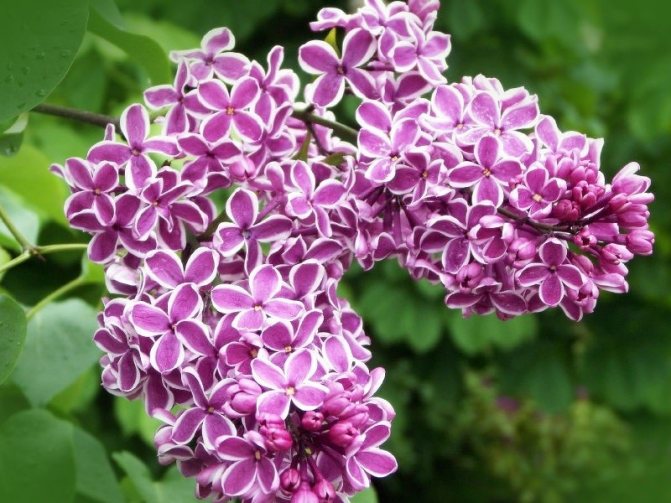

The main difference between this lilac is the white border on the flowers. This variety never gained much popularity.
A similar subspecies is "Sensation", its flowers are slightly larger, and the color is warmer.
The same rare specimens include: "Marshal Zhukov", "Great Victory", "Defenders of Moscow", "Fiftieth Anniversary of October", "Moscow University" and "Daughter Tamara".
White varieties of Kolesnikov lilac
"Beauty of Moscow" is the most famous variety of all his creations.
Its stunning pale pink buds and snow-white flowers are complemented by a delicate scent of lilac that will not leave anyone indifferent. The same variety is in the title photo.
Galina Ulanova is the owner of large pearl-white flowers with a strong scent. Lush inflorescences seem completely weightless and delicate.
Her sophistication was appreciated even at Buckingham Palace.
"Memory of Kolesnikov" - has large rounded flowers and delicate inflorescences. This variety is known in narrower circles of lilac lovers.
"Soviet Arctic" is another inimitable subspecies that undoubtedly pleases the eye.
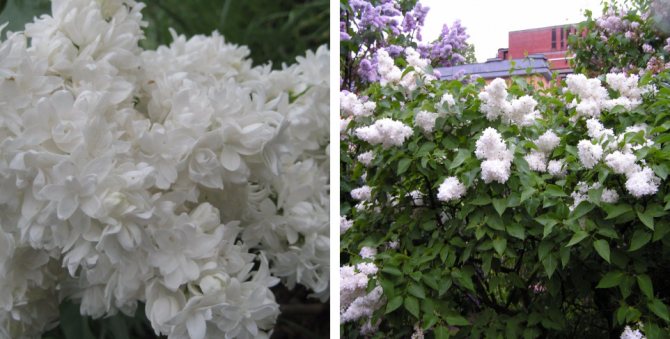

"Bride" is the most delicate representative of this plant, pinkish-white petals create a touching impression.
"Polina Osipenko" - has white flowers with light shades of blue, purple and pink.
Kolesnikov's purple lilacs
It should be noted right away that red varieties of lilacs are a convention. The most "red" are the representatives of the sixth group of varieties - magenta, that is, purple-reddish, as well as representatives of the complex seventh group, which includes purple varieties that are redder than traditional purple, but at the same time bluer than magenta ...
Kolesnikov's purple varieties include:
Sholokhov
"Caprice"
M. I. Kalinin "
"Granddaughter Helen"
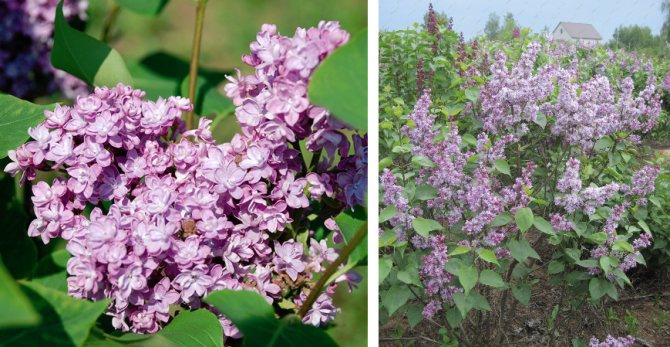

"Red Moscow" - one of the most famous, the owner of bright purple inflorescences growing upward. The color is difficult to capture in the photo.
"Dawn of Communism" - inflorescences are large and heavy, attract with their purple-red color with purple overflow.
"India" - has long inflorescences, reaching up to 40 cm. Color - purple-violet with a red tint.
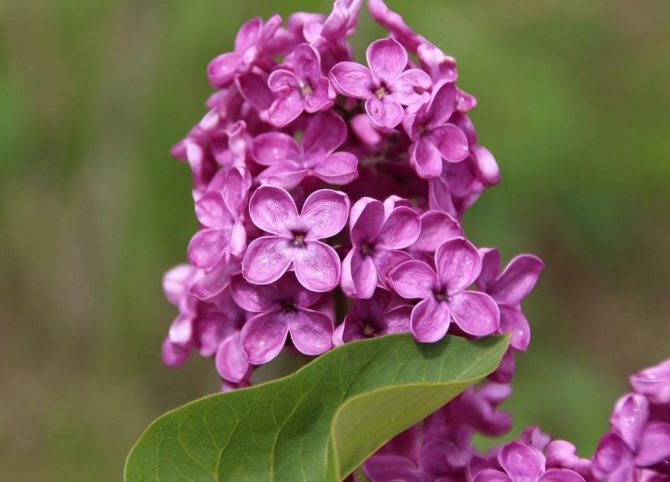

"Abundance"
Captain Gastello - has purple-lilac flowers, with swirling petals, which gives the impression of a curly panicle. Inflorescences are slightly drooping.
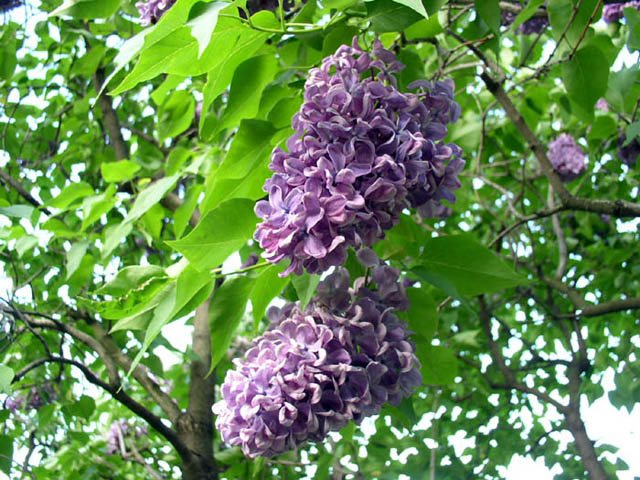

Kolesnikov's pink lilacs
"Hydrangea" - has large 30 to 30 inflorescences that cover the entire bush in lush color.
Hydrangea variety towards the end of flowering
Kolesnikov Olympics - the flowers are pale lilac, fervently twisted in different directions, the buds are darker.
Kolesnikov's blue and purple lilacs
"Morning of Moscow" - has large, densely double inflorescences of mauve color.
"Blue" - has a faint aroma and purple-blue inflorescences. There are very few photos of the variety on the network; it is also difficult to find the variety in nurseries for sale. We tried to select interesting but affordable varieties, but this one is an exception.


"P. P. Konchalovsky " - owners of heavy double flowers of light purple color.
"Hope" - a bush of medium height, inflorescences are very dense.
"Sky of Moscow" - This is a chameleon variety, has a complex, difficult to catch in the photo, color.
The medicinal properties of lilacs and contraindications
Lilac flowers and leaves have been used since ancient times in folk medicine to treat various diseases. They are used as one of the components in the preparation of herbal preparations or as an independent tool.
- An aqueous tincture of lilac flowers has a diaphoretic, antimalarial and analgesic effect. It is used to treat whooping cough and kidney diseases, headaches, and colds. An infusion of white lilac flowers is used for shortness of breath, stomach ulcers and elimination of noise in the head.
- Lilac leaves, like plantain leaves, heal festering wounds, as they have disinfecting, antibacterial properties.
- Lilac ointment and alcohol tincture are used to relieve pain and treat rheumatism and salt deposits in the joints of the upper and lower extremities.
- An infusion of lilac leaves is an indispensable remedy for the treatment of festering wounds; it is used as a drug with antipyretic and diaphoretic effects.
- Tea made from lilac flowers shows its medicinal properties in the fight against colds, colds, flu, whooping cough, kidney stones.
- The beneficial properties of lilacs are also manifested in the oil, which is obtained from the bark of the plant. Lilac oil is used for diseases of the upper respiratory tract: it has antibacterial and expectorant properties and can be used for inhalation. Also, lilac oil is used for relaxing aroma baths, against skin infections, rashes, acne, boils. It can also be used for body massage as it has a great scent. In the old days, lilac essential oil was also used as an antihelminthic or antiparasitic agent.
- Lilac twigs, placed in a vase in the room, scent the air, relax and help you fall asleep.
- Due to the fact that syringin glycoside is included in the composition of lilac flowers, which releases hydrocyanic acid toxins during the decomposition, infusions taken orally should be used with caution.
Photo gallery
Purple and purple lilacs:
With simple flowers:
Photo gallery
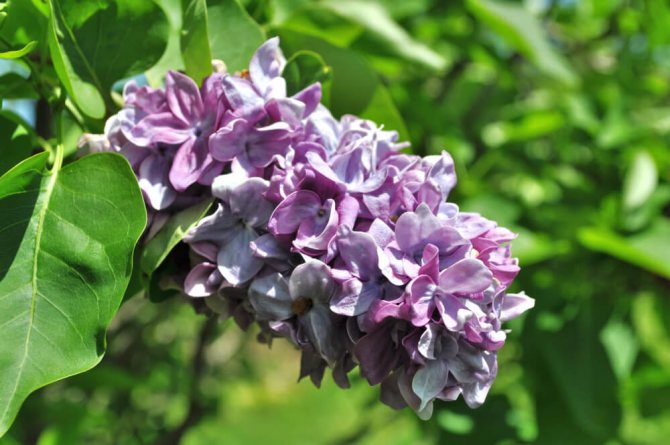

Lilacs lilac-pink, pink, purple-pink:
With simple flowers:
Photo gallery
Blooms in June, about 2 weeks. The inflorescences are openwork, formed from the lateral buds of last year's shoots. It blooms and bears fruit annually from the age of 6. Hardy, but sometimes freezes in severe winters.
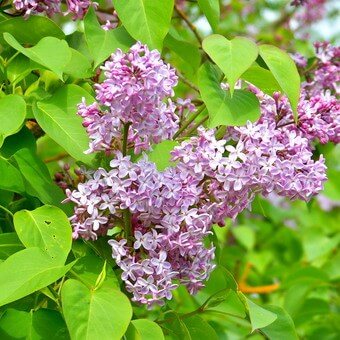

Common lilac (S. vulgaris). The bush is up to 4 m high. The flowers are located in the upper part of the shoot, small, non-double, light purple or white in color. It has a very strong odor. Blooms in May-June, about 2 weeks.


Known form ‘Aucubafolia’ (‘Aucubaefolia’).The flowers are simple or semi-double, bluish-lilac, the leaves are dark green with yellow spots, strokes and stripes.
Pay attention to the photo - in decorative lilacs of this type, the shape and size of inflorescences in different varieties is different, from small to large, from pyramidal, conical, round to cylindrical, from drooping to erect, from loose to compactly dense:
Lilac breeding methods and how to grow a shrub from a cuttings (with video)
Reproduction of lilacs can be carried out in several ways: by seeds, cuttings, using layering or grafting. Let's say right away that vaccinations are a technique that is only suitable for experienced gardeners.
As for other methods. For example, this method of propagation of lilacs as seeds is multifunctional: firstly, it is suitable for breeding various types of shrubs, and secondly, with their help, you can grow seedlings suitable for grafting.
However, keep in mind that these plants are slightly slower in growth and need proper care.
By the way, with the help of the shoots, you can also grow a new generation of this shrub. For this, the shoots should only be planted. However, check the moment so that the mother plant has a healthy root system. This does not apply, for example, to bushes that have been removed by grafting.
And how to grow lilacs so that the roots are healthy and can further help in increasing the number of specimens for planting? The answer is simple - you should use green cuttings. They must be summer, as winter material will not be able to take root.
Remember that this procedure cannot be carried out with all plant varieties. More or less suitable are those that give flowering from double buds - for example, "India" or "Montaigne".
To even better understand how to grow lilacs from cuttings, you should learn more about such a moment as the timing of their separation. Gardening experts say that it is best to carry out vegetative propagation immediately after the shoots stop growing in length. This period falls on the lush flowering of the plant.
In addition, it will be favorable for grafting if the bush from which the particles are separated for reproduction turns out to be as young as possible.
It should also be noted that it is better to separate the cuttings from those branches that are in the center of the crown of the shrub. Get them with a razor or sharp knife. By the way, if you are not too lazy, you can treat each extracted cutting with a preparation that will stimulate the process of root formation.
Cuttings are most often immersed in a substrate that is breathable and moderately humid. This material can be, for example, a mixture of peat and sand. In the rooting container, the cuttings must be placed vertically.
This is done so that the lower kidneys are completely covered. Do not forget to spray the plants after this and carefully close the greenhouse. By the way, the film that is used for covering is pulled closer to the cuttings. But then they carefully monitor that the rooting process proceeds correctly: for this it is necessary to control so that the water in the greenhouse does not stagnate. Therefore, the next spraying of the plant is carried out only after the past water has dried on the leaves of the cuttings.
Remember that the cuttings will have roots in about ten weeks. But this does not mean that the plant is ready for planting. In fact, cuttings with a root system that has already begun to form are moved out of the greenhouse only next spring. Better yet, in the fall.
Do you still feel a little uncomfortable with taking on such a responsible business? Then let's watch a video of lilac breeding, which will finally help you understand all the nuances:
Photo gallery
With double flowers:
New varieties of lilac
In 2019, new varieties were selected and presented: “Admiral Nakhimov”, “Akademik Kurchatov”, “Alexander Prokhorenko”, “Anastasia Shirinskaya”, “Belomorye”, “Vologda lace”, “Memories of Pavlovsk”, “Elena Anzhuyskaya”, "Icebreaker", "Summer Garden", "Honey Savior", "Mercy", "Moskvichka", "Myshkin", "Origami", "Farewell of the Slav", "Aphrodite", "Sevastopol", "Quiet Abode", "Tsarskoselskaya "," Shishkin Les "," Elbrus ".
"Alexander Prokhorenko"
Named in honor of the hero of the Russian Federation, who died in the line of military duty in Syria.
Lilac blue color
Such inflorescences look very delicate and will give a feeling of lightness and freshness to every garden.
"Mark Micheli"
"Christopher Columbus"
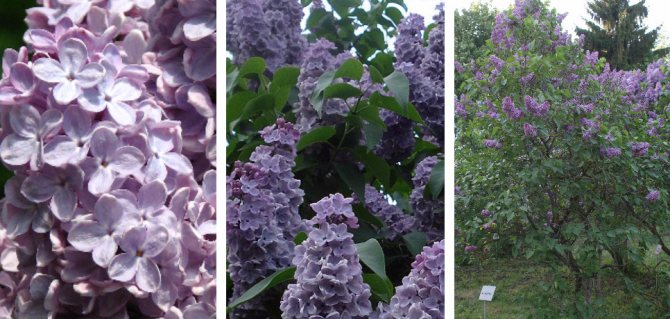

"Condorcet"
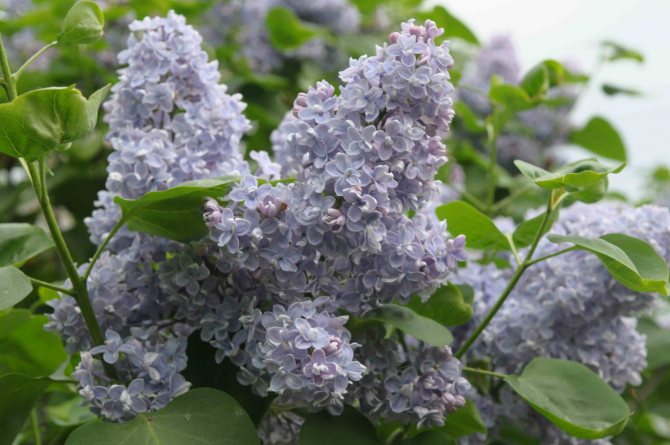

"President Grevy"
Photo gallery
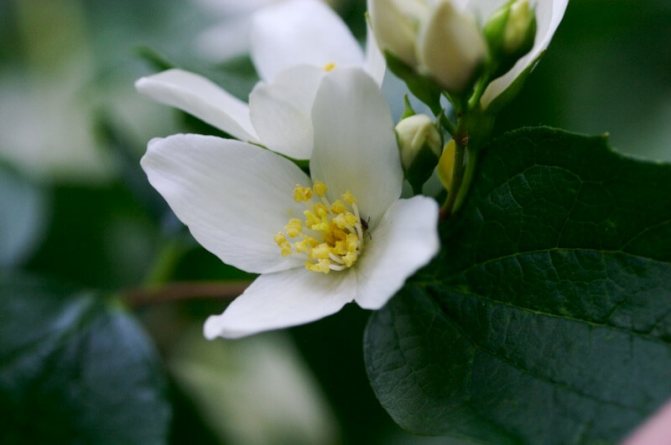

Lilac diseases and pests: control, treatment, description and photo
Lilacs are rarely affected by pests and various diseases, but this fragrant beauty also has "health problems." The most dangerous and common ailments and pests of lilacs are considered the following:
- Bacterial (non-cystic) necrosis of lilac
the disease usually begins to progress in early to mid-August. Signs of garden lilac disease are, first of all, a change in the color of the leaves from green to ash-gray, and the young shoots of the bush and branches become brown or brown. Control measures: thinning the plantings of lilacs for optimal ventilation, timely control of insect pests, as well as cutting and burning all damaged parts of the bush, or completely removing a heavily infected plant by uprooting.
- Powdery mildew on lilac (caused by the fungi Microsphaera syringae, Microsphaera penicillata f. syringae)
It also quickly affects young seedlings and adult bushes. Lilac leaves turn white, a powdery coating of gray-whitish color becomes noticeable on them. Especially often the disease occurs in dry and excessively hot summers. Control measures: the infected parts of the lilac must be removed and burned. In early spring, bleach (100 g per sq / m) should be added to the soil and carefully dig up the soil, trying not to disturb the roots of the bush.
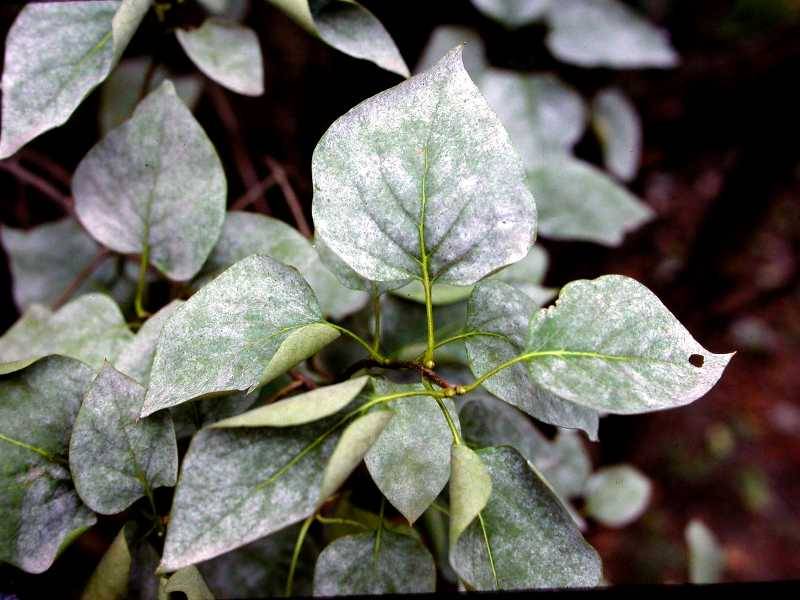

- Lilac verticillary wilting
This disease is provoked by the fungus Verticillium albo-atrum, the leaves of the lilac curl, brown or rusty brown spots appear on them, the leaves dry, wither and fall off. Lilac dries up (usually from the top of the head) and quickly dies. Treatment: treatment of the bush during the growing season with a solution of soda ash and laundry soap in a ratio of 100 grams (1: 1) per 15 liters of water, spraying with Abiga-Peak, as well as burning fallen leaves and damaged shoots.
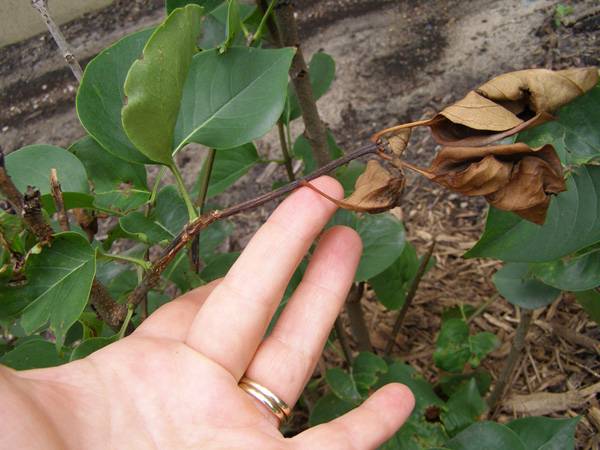

- Lilac leaf mite (Eriophyes saalasi)
this tiny insect with appetite sucks the juices from the underside of the leaves, as a result of which the lilac leaves turn brown and dry. Large populations of the pest are capable of destroying a healthy and large bush in a couple of weeks. Control measures: apply phosphorus-potassium fertilizers to the soil of the near-trunk circle, prune thickened branches, process bushes with copper or iron vitriol, burn a leaf-fall before the onset of winter.
- Lilac kidney mite (Eriophyes loewi)
The whole life of this pest passes in the buds of a lilac bush, where it feeds on plant juices and hibernates there. As a result, the buds are deformed, weak, underdeveloped leaves and shoots appear from them, as a result, the lilac does not bloom and often dies in the second or third year. Treatment: treatment of the bush with copper sulfate, as soon as the frosts pass (before bud break), removal of dry foliage and basal shoots, autumn digging of the soil around the bush with no less than a full bayonet of a shovel with overturning the layers.
- Lilac miner moth
an insect pest that quickly infects the leaves of a plant. Initially, lilac leaves are covered with dark brown spots (mines), after a while they twist into a tube, becoming as if burnt.Moth-affected lilac bushes stop blooming, dying after 1-2 years. Control measures: deep digging of the soil with thorough turning of the soil under the bush before frosts and in spring, pruning of affected leaves and their subsequent burning. An already infected plant should be treated with Bordeaux liquid, "Bactofit" or "Fitosporin-M", after spraying abundantly over the foliage.
In any case, pay attention to the planting material: the seedlings should have a well-formed root system, glossy buds with tightly attached scales and leaves of a healthy green tint with a smooth matte or slightly glossy surface.
How to keep cut lilac fresh: tips
How to keep freshly cut lilacs in a vase for a long time, planting and caring for which at the exit caused a chic, beautifully formed bouquet? To do this, you need to know a few subtleties of such a delicate operation.
You need to cut it in the early morning, while removing most of the leaves from the branches, because they evaporate a lot of moisture. Cut lilacs last longer from young bushes than from old ones. The inflorescence should have at least 2/3 of the opened flowers, because the buds will not bloom in the cut. Before placing a bouquet in a vase, you need to refresh the oblique cuts by making new ones under water. A tricky but effective technique: crush the ends of the shoots with a hammer. It is recommended to add 2-3 grams of acetic or citric acid to the water. A withered bouquet can be freshened up by placing it in very hot water.
Photo gallery
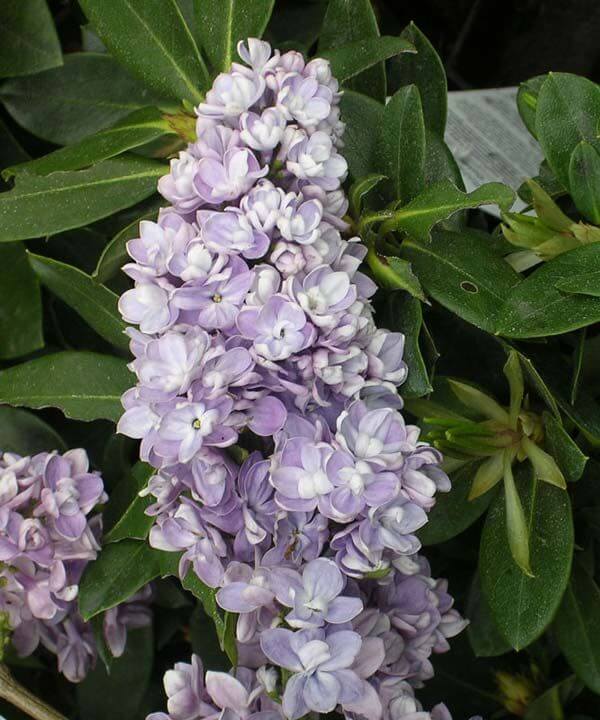

Unusual varieties of lilacs:
‘Beauty of Moscow’... Legendary variety. It is considered the most beautiful lilac in the world. The buds are pale pink. The flowers are pearl white, double, large, resembling roses.


‘Primrose’ ('Primrose'). The only yellow lilac. The buds are light yellow, large simple flowers at the beginning of dissolution are light yellowish cream, gradually turning white.
‘Sensation’ (‘Sensation’), ‘Dzhambul’ - the petals of large purple simple flowers have a clearly defined white border.
Look at the photo of how lilacs of various varieties look like:
Growing lilacs
In order for the Hungarian lilac to grow favorably, all planting conditions must be taken into account: lighting, soil, humidity and weather conditions.
Creation of favorable conditions
Location
Hungarian lilac is suitable for cultivation in urban conditions, and with strong air and soil pollution.
It develops well even next to highways and on the side of the roadway, without suffering from exhaust gases and dust. In this case, it is better that the landing site is protected from the wind.
Lighting
Lilac is a light-loving shrub, and it is better to plant it in a brightly lit place. But at the same time it can be placed in partial shade conditions.
The soil
Lilac does not make high demands on the composition of the soil. But if you plant it on a wetland, which is heated in the spring and autumn, this can lead to decay and death of its roots.
They are sensitive to moisture. The ideal location would be to plant on fertile, moderately moist soils, with a good drainage layer. In terms of acidity, slightly acidic and neutral soils are suitable for it.
It should be remembered that it is better to plant lilacs at the end of July and August. When planted in soil seized by frost, it will not take root.
Landing
It is best to plant the shrub in late August or early September. Since if you plant it in early spring, then this year the growth of lilacs will be very slow. At the same time, it is better to plan the landing in the evening, without the open sun.
Before planting, the soil must be well loosened. Landing holes are dug deep, with sheer walls.
Their size should be 50 to 50 centimeters on fertile soils, and one meter to one meter on poor sandy soils. The pit is filled with a substrate of mineral and organic fertilizers, although you can do without them.
It is necessary to maintain a distance of about 3 meters between the bushes.
When planting a seedling in a pit, it must be positioned exactly in the center, and so that the roots look down and the stem is vertical. Immediately after planting, the shrub must be shortened to a distance of two or three buds, watered abundantly and mulched with humus or last year's leaves.
Then the soil must be loosened at the roots, about 4 times per season.
Watering
Additional watering of the shrub is necessary only at the stage of growth and flowering. If the dry weather lasts for a long time, then additional moisture will also be needed. The shrub tolerates periods of drought and summer heat well.
Transfer
Lilac easily tolerates a transplant at any age. At the same time, it can be transplanted at any time, although it is better to prefer the usual terms, standard for all shrubs.
Fertilizers
In the first two years after planting lilacs, it needs to be fertilized nitrogen
contained in urea and nitrate.
After that, she needs to be fed. manure solution
and water, in a ratio of one to five.
In this case, you need to fertilize carefully, at a distance of 50 centimeters from the trunk, in order to avoid rotting.
In the autumn period, lilacs are fed with fertilizers. potash and phosphoric
composition, approximately once every three years.
Fertilizers are applied 6-8 centimeters deep.
Pruning
The crown shape of lilacs is quite strict and does not require significant adjustments. Annual pruning is carried out in order to maintain the shape of the crown, and in order to thin out branches, letting in sunlight inside the shrub.
In the first years after planting, lilacs do not need pruning, and therefore the formation of the skeleton and sanitary pruning begin to be carried out 3-4 years after planting.
It is best to prune in the spring before the buds swell. You also need to carefully examine the branches and not cut off those that will give flowers this year.
It is better to prune the branches inside the bush and allow the young branches to develop.
Hungarian lilac wintering
This shrub tolerates winter cold well, even in the most northern regions. Lilac quickly recovers after cold winters, and its shoots develop until the very frost.
She does not require any preparation for the winter period and shelter, even after planting, at a young age.
Reproduction
In the absence of offspring in lilacs, reproduction becomes more difficult. But at the same time, about 90% of its cuttings take root, with the very minimum care.
Therefore, when using the cutting technique, new shrubs can be obtained without much difficulty. You can root both green shoots and twigs that are already lignified.
You can also get new shrubs through seed propagation. Sowing is carried out after the seeds are kept for two months at an ambient temperature of about 5 degrees.
It is better to sow in spring or autumn on the beds, which are prepared in advance. You can buy seeds at any flower shop.
Photo gallery
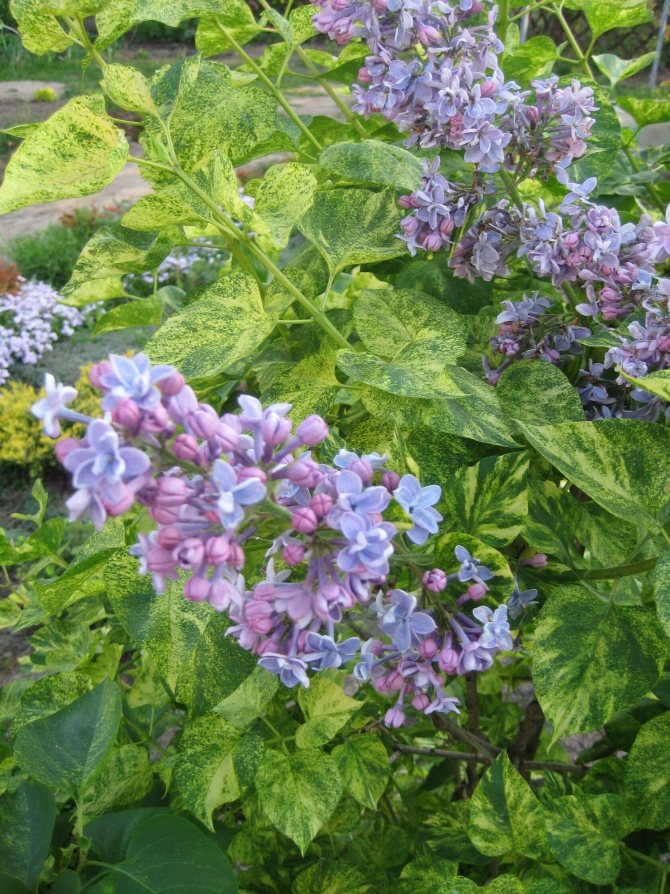

The color of the varietal lilac flowers is very diverse: white, blue, violet, lilac-pink, cream, purple, etc. The flowers are simple, semi-double and double.
Here you can see a selection of photos of the species and varieties of lilacs, the most popular in the middle lane:
Advantages and disadvantages of undersized lilac
Among other mini-shrubs, dwarf lilac stands out for a number of advantages. These include:
- High frost resistance. Some varieties are able to withstand temperatures as low as -40 ° C without additional insulation.
- Unpretentious care. One organic feeding of a young plant is enough for 2-3 years.
- Drought resistance. The shrub can withstand up to 7 days in the heat without additional irrigation.
- Low vegetation potential. Perennial dwarfs are characterized by slow growth rates, and therefore gardeners do not have to worry about crown density.
- The crown's ability to absorb exhaust gases and toxic volatile compounds from the surrounding atmosphere.
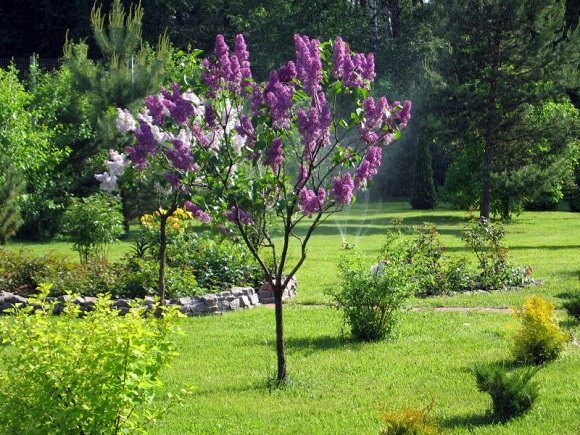

Shrub formed in the form of a trunk
Among the shortcomings, it is worth noting the low rooting rates. Most of the undersized varieties (except for Mayer's species) get sick for a long time after transplanting to a new place. In the first 2 years after the manipulations, the plants need more careful care.
How to properly prune lilacs after flowering
It is necessary to bring beauty - that is, to prune lilacs - wisely: remember that if you engage in this procedure too selflessly, this is fraught with the active growth of new shoots that you do not need at all - they only give a sloppy look to the crown of the bush. In this case, gardeners recommend removing about 20% of all branches in one haircut.
What else you need to know is the lilac pruning scheme, which includes two techniques: one is necessary to remove those very branches in the crown, and the second is to trim old inflorescences.
You must always remember that injuring the bush - making cuts that exceed 3 cm - is strictly prohibited! This is fraught with the fact that your young or already adult plant will start to rot, and then die. Unfortunately, lubrication with a special pitch will not help either: it will slightly slow down the decay process, but will not stop it.
To understand how to prune lilacs, you need to understand for yourself that this plant is grown either as a shrub or as a standard tree. Therefore, to the question of how to cut lilacs after flowering, we will answer you as follows: the haircut procedure is carried out so that after it the largest trunks remain in adult specimens - no more than four pieces, and yet the rest was carefully and neatly cut off.
The pruning technique is to make the selected branches look in different directions. In the future, the branches of the bush will certainly be ennobled, that is, they remove unnecessary shoots from the bottom and in the center.
This will protect the shrub from any damage. And to ensure a successful haircut, prune the lilacs after flowering or in early spring.
Frost-resistant varieties
For the harsh climate of our country, it is important that the plant safely survive the cold winter conditions. Below we give a list of just such varieties.
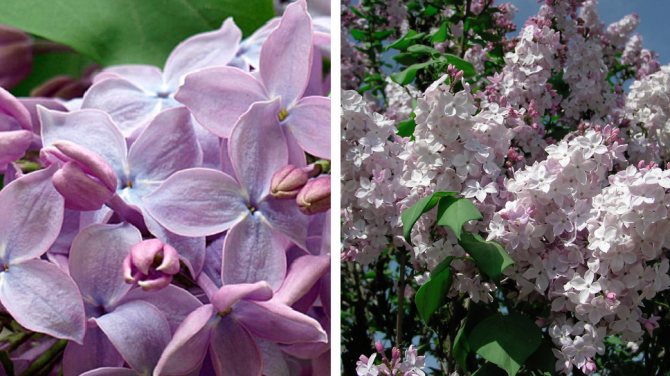

Clark's giant
Lilac Excel
Maiden's Blush
Small-leaved Superba (microphylla Superba)
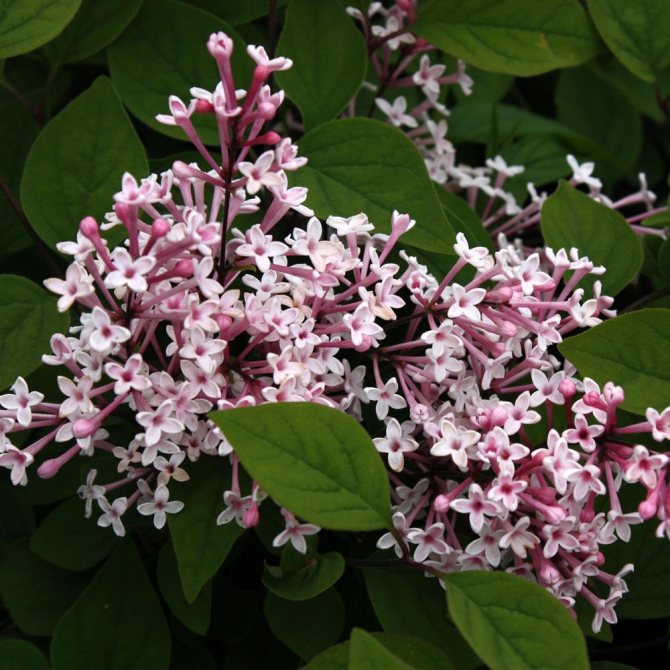

Preston hybrid with original tubular flowers, cultivar James Macfarlane:
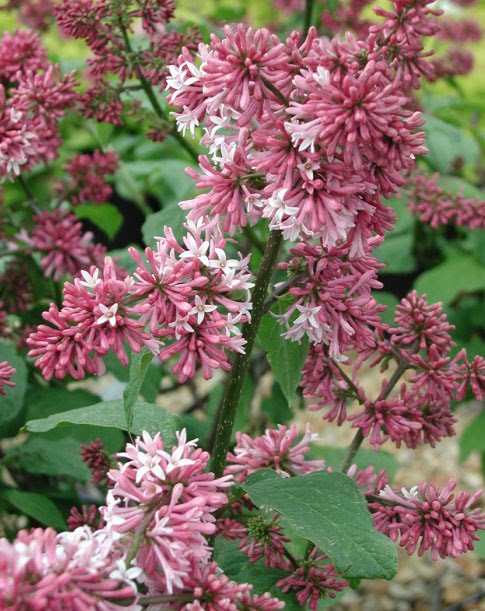

Miss Poland
Adelaide Dunbar
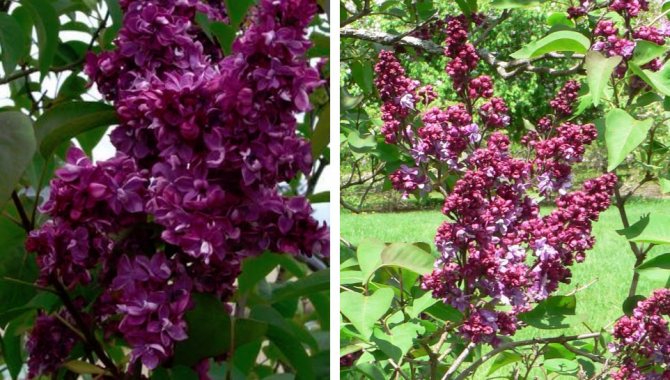

Common lilac Amethyst (Syringa Vulgaris Amethyst)
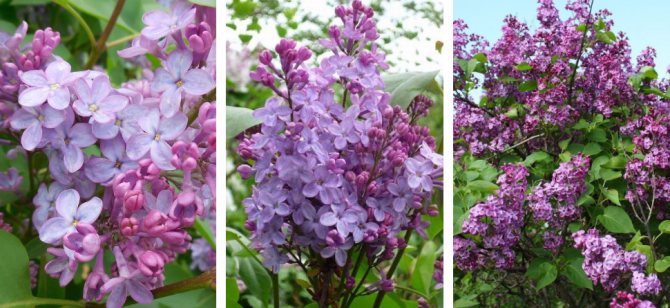

Duc de Massa
Taras Bulba
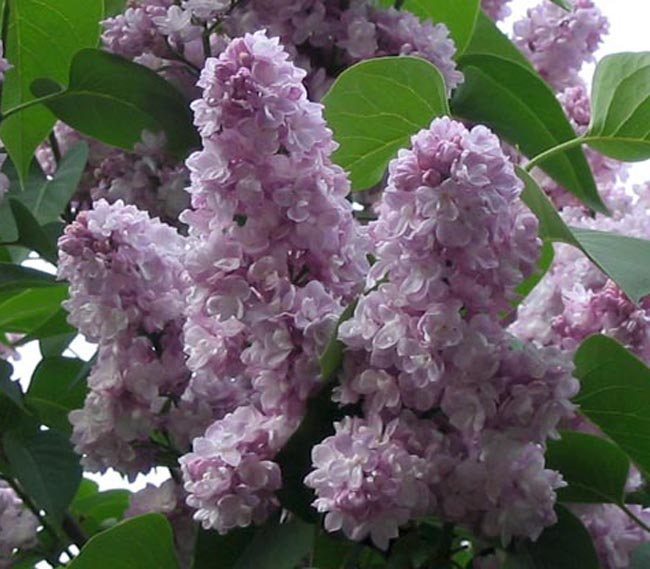

The darkest varieties of lilac
Such vibrant bushes rich in color will definitely refresh and add color to your garden.
The most beautiful of these representatives.
"Dusk"
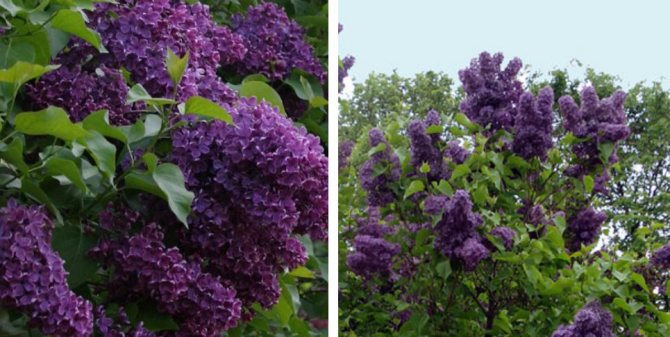

"Minchanka"
Danton
Where does lilac grow?
Wild lilac in natural conditions is distributed only in Europe and Asia, as well as the islands of Japan. Its habitat is limited to three isolated mountain areas:
- Balkan-Carpathian region, which includes Albania and Serbia, Croatia and Hungary, Slovakia and Romania.
- Western Himalayan region, which includes India and China, Nepal and Pakistan, and Bhutan.
- East Asian mountainous region, represented by the territories of East and Central China, Primorsky Krai, Japan and the Korean Peninsula.
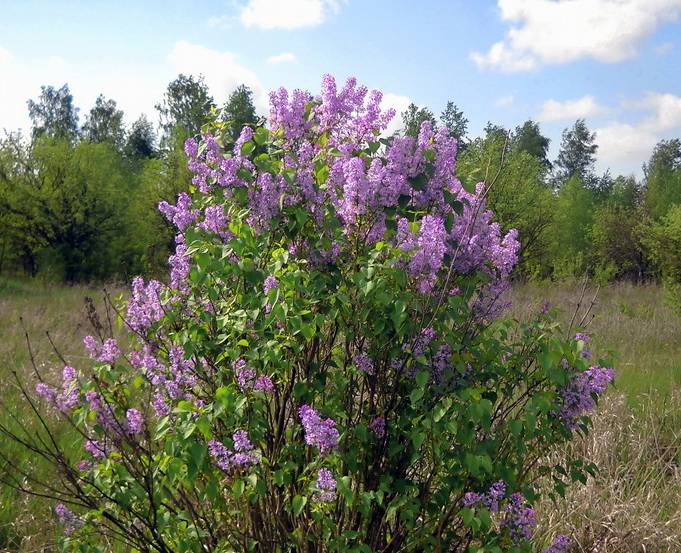

Lilac cultivars grow throughout Eurasia, from Portugal to the shores of Kamchatka, cover part of the coast of the African continent (Morocco), feel great in the countries of North and South America, as well as in Japan.
Genus history
Genus Lilac (Syringa) belongs to the olive family and has about 30 species growing in Southern Europe, Northeast Asia and Iran. These are deciduous, with rare exceptions, evergreen shrubs with a dense leafy crown. The flowers are bisexual, fragrant, white, lilac, violet, purple in color.Collected in multi-flowered apical or axillary paniculate inflorescences that appear simultaneously with the opening of the leaves.
The fruit is an oblong or oval leathery capsule with two seeds behind each leaf.
It is interesting
Lilac is perhaps one of the most demanded and beloved crops. The history of her breeding began in 1583. It was then that, calling the lilac Turkish viburnum, the Austrian envoy brought the seeds of this unusual plant from Constantinople to Vienna. Since then, it has been the leader in the list of the most highly decorative and flowering shrubs.
The homeland of most types of lilacs is China, but this beauty has long been cultivated in other countries, where it is treated with great respect, and breeders have created a huge number of magnificent varieties.
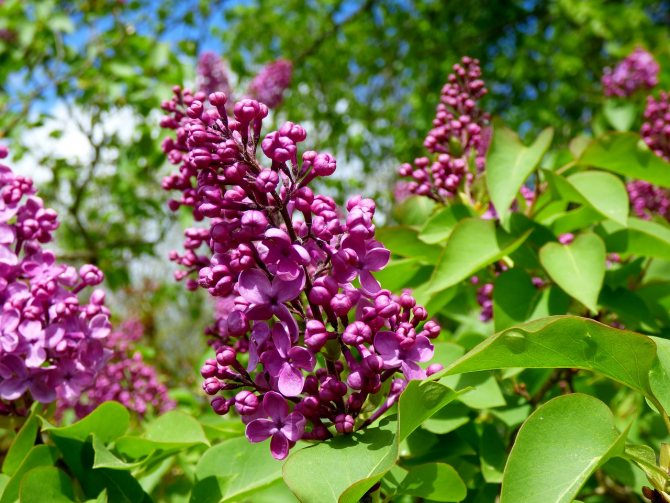

In Russia, this plant is also very popular and loved. For a long time, fragrant lilac bushes adorned the royal and monastery gardens, private estates and parks. Currently, different types of lilacs are widely used in urban landscaping and in personal plots.
Lilac - description and photo
In most cases, lilac is a shrub with many upright or spreading trunks up to 5-7 meters high, less often the plant has outlines characteristic of a tree.
The lilac bush is abundantly covered with foliage, which is located on the opposite branches and stays on them until late autumn. Depending on the type of lilac, leaf plates are simple with an even edge, ovoid, oval or elongated in shape with a pointed nose, as well as feathery and complexly dissected.
Lilac leaves are light or dark green in color, and their length can reach 12 cm.
The funnel-shaped flowers of the lilac are rather small with four petals. They form racemose or panicle inflorescences. The number of flowers on one lilac bush during flowering can reach 18,000 pieces.
The color of lilac can be pink and purple, white and purple, blue and purple. In most types of lilacs, an admixture of another color is added to the main monochromatic color. The scent of lilac is very delicate, subtle and has a calming effect.
Elongated lilac fruits are a bivalve box containing several seeds with wings.
Most popular representatives
"In memory of Ludwig Shpet" - widespread due to its dark color and delicate aroma.
Andenken an Ludwig Späth
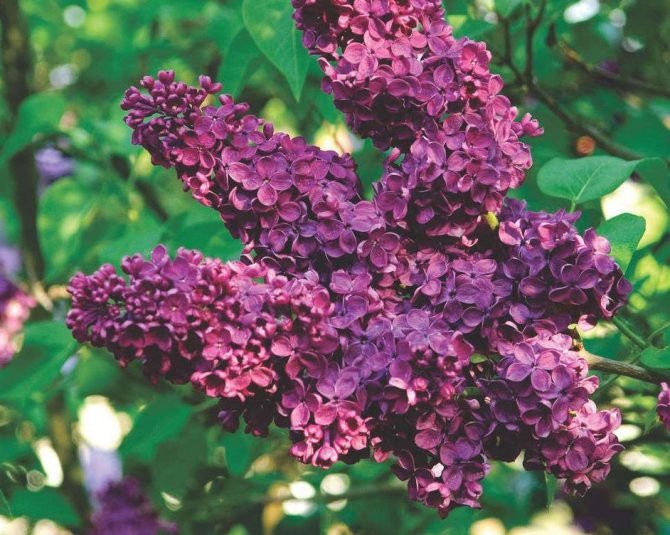

Common lilacs "Krasnaya Moskva", "Beauty of Moscow", "Primrose", Meyer's Lilac, "Buffon", "Charles Joly" are no less popular and attractive. They were also noted by gardeners as the most fragrant specimens.
Monique Lemoine, Flora, Nadezhda, "Memory of Vekhov", according to reviews, distinguished themselves by their unique flowering, and therefore they are so desirable in the plots of every gardener.
Each variety is unique in its own way, and among such a riot of colors, everyone will find what they like.
Photo gallery
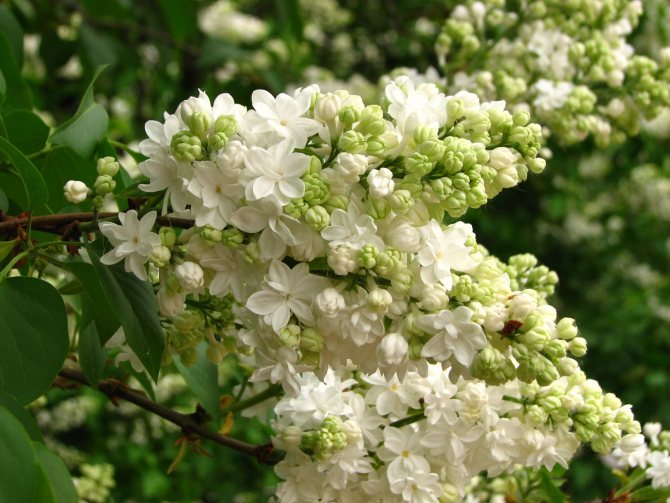

Lilacs are blue, lilac-blue and lilac in different shades:
With simple flowers:

